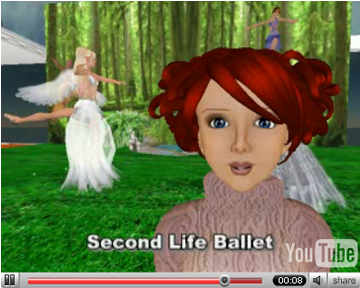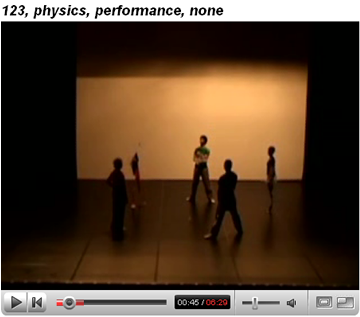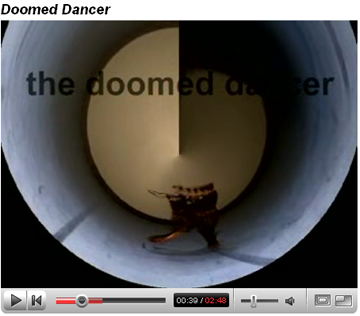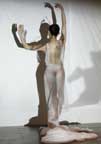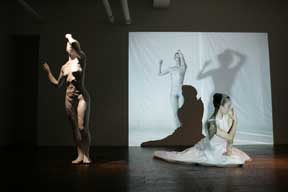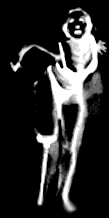June 29, 2007
Double Skin/Double Mind
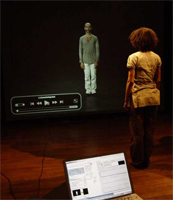
Experience a workshop, virtually
The interactive installation version of Double Skin/Double Mind will preview at Beeldmedia Studio, Amsterdam School of the Arts, Jodenbreestraat 3 on June 29 + 30 from 16:00-20:00.
Double Skin / Double Mind is a virtual version of the Double Skin / Double Mind workshop. This workshop, which has been taught by dance company Emio Greco | PC since 1996, represents the basis of the creative work of choreographers Emio Greco and Pieter C. Scholten. Participants in this workshop are challenged to discover new interpretations of their dancing body.
Throughout 2006 an interdisciplinary research group, consisting of dance notators Eliane Mirzabekiantz and Marion Bastien, motion capture researcher Fridiric Bevilacqua, cognitive neuroscientist Corinne Jola, media artist Chris Ziegler, cinematography Maite Bermudez, artistic research processes Scott de Lahunta and EG | PC researcher Bertha Bermudez, has been focusing on this specific workshop trying to analyse and document it.
The different data from each research area have been collected, and interactive graphic visualisation tools and motion capture were re-implemented to create this preview of the Interactive Installation Double Skin / Double Mind. The current installation offers participants the possibility of taking part in a virtual version of the workshop in real time, while receiving verbal, physical and peripheral information. By following a life size moving figure, the participants will recognize, compare and understand their actions and involvement in the practice of this workshop. They will travel through the Double Skin / Double Mind structure in a mental and physical way, experiencing what the different layers are.
Concept and realization: Chris Ziegler (ZKM Karlsruhe), Fridiric Bevilacqua (IRCAM, Paris), Bertha Bermudez (Emio Greco | PC)
Co-production with: Amsterdams School of the Arts, research group Art Practice and development, Marijke Hoogenboom
With thanks to: Maite Bermudez, Katharina Pohlmann, Eliane Mirzabekiantz, Marion Bastien, Corinne Jola, Nederlands Instituut voor Mediakunst / Montevideo, Scott deLahunta, Jeroen Fabius, Paul van der Ploeg, Cinedans and the EG | PC team
Project supported by: Prins Bernhard Cultuurfonds
Emio Greco | PC receives funding from: the Dutch Ministry of Education, Culture and Science and from the Dutch Fund for Amateur Art and Performing Arts.
contact: berthabermudez]at]egpc.nl
Chris Ziegler
mobile +49172 89 56 328
http://www.movingimages.de
Posted by jo at 11:05 AM | Comments (0)
June 22, 2007
Merce Cunningham - Biped
Posted by jo at 08:56 AM | Comments (0)
June 20, 2007
Locus Tangent Return
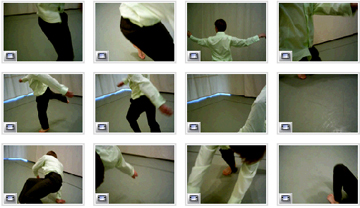
Invitation to Re-Construct, Re-Mix, Re-Choreograph
From Hyperchoreography: The video clips for Locus Tangent Return were shot on 2 DV-5 D'zign HDD camcorders. The dancers improvised movements based on a series of instructions. The focus of these movements was repetition of simple gestures and building complex sequences. Sometimes these would accumulate in length or sometimes they would multiply by superimposing, and sometimes they would take a movement from the other dancer and drop one of their own. On top of this they had to work with the concept of the title: Postion - Locus :: Change - Tangent :: Repetition - Return. Short video clips have been extracted from the recordings and made available for re-construction, re -mixing and re-choreographing to create new works.
Posted by jo at 11:29 AM | Comments (0)
June 01, 2007
UNIQLO MIXPLAY
Go here to mix your own dance and sound.
Posted by jo at 05:47 PM | Comments (0)
May 29, 2007
Reconfigurable Costume
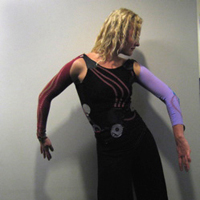
A Platform for Interactive Performance
Leah Buechley's reconfigurable costume consists of a torso piece and an assortment of sensing appendages that can be snapped to the torso. Sensors in the appendages include muscle flex sensors, accelerometers, bend sensors and touch sensors. Sensor data is relayed to a computer, via a bluetooth module embedded in the torso, where it can be used to control or generate music, video and other multimedia content.
The costume, built using her version 2.0 e-textile construction kit, is form-fitting and stretchy. The electronic modules are kept as small as possible so they do not interfere with the dancer. The costume was used in an improvisational performance in May, 2007 to control a player piano. This performance was a collaboration with Michael Theodore, a professor in the music department, and Nicole Predki, a graduate student in the dance department. Click here for a movie (150MB).
Posted by jo at 06:37 PM | Comments (0)
May 21, 2007
Technologically Expanded Dance
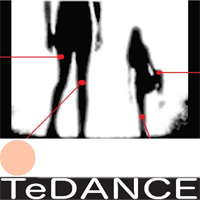
Call for Participation
Technologically Expanded Dance: Call for formal presentations, art installations and pocket performances :: November 22 - 24, 2007 :: CULTURGEST, Lisbon Portugal.
The Faculdade de Motricidade Humana, TU Lisbon, is pleased to announce the Conference Technologically Expanded Dance. The following conference topics will be considered: 1. Cross modal perception, artificial synesthesia and intermedial relations between artistic languages 2. Motion capture systems and archives of body movements 3. Aesthetic signification of technology 4. Transfers from game structures onto audible, visual or kinetic narratives 5. Corporeality and new technologies 6. Virtual and augmented reality applied to the stage.
CULTURGEST has a small auditorium, 4 rooms and 1 foyer that could host pannels on the above themes, media art installations, new media artworks and pocket performances. Submitters are invited to check the rider of the hostage spaces within the perspective of site-specific*. Eventually submitters should provide their own equipment. Proposals should be submitted online by 29 June 2007. Following an evaluation by the reviewers, authors will be notified by the end of July 2007.
Posted by jo at 01:06 PM | Comments (0)
May 17, 2007
Men in the Wall

Men in the Wall by Liz Aggiss and Billy Cowie :: Opening Reception: Wednesday, June 20, 7 – 10 pm :: Artist Talk 7:30 p.m :: Installation runs June 20 – 30 :: 1639 18th Street, Santa Monica, CA 90404 :: FREE admission :: 310-453-3711.
Men in the Wall is a four-screen, 3-dimensional stereoscopic video dance installation. Special stereoscopic glasses will be provided to watch this 3D world of four men, who share their framed lives in a public quartet while retaining their private differences. The piece runs on a continuous 25-minute loop and will be projected from four different projectors onto the wall.
Billy Cowie and Liz Aggiss principally work together in the area of dance/theatre performance, screen dance and installation. They have made over thirty live performance pieces for their company Divas Dance Theatre, have toured Europe extensively and completed four major screen projects (two BBC Dance for Camera commissions and two ACE Capture projects).
They have created commissioned work for 'Extemporary Dance Theatre',' Mantis', 'Transitions', 'Intoto', 'Carousel' and 'Hi Spin'. Aggis and Cowie’s dance screen work has received numerous international awards including: Czech Crystal, Prague Golden Film Festival (2002); Special Jury Golden Award, Houston (2003); Best Female Film, Mediawaves Hungary (2003); and the Romanian National Office of Cinematography Award (2003). A book about their work entitled Anarchic Dance was published by Routledge in January 2006.
Billy Cowie has composed music performed by Marie McLaughlin, Nicola Hall, Gerard McChrystal, Daphne Scott-Sawyer, Juliet Russell, Rowan Godel, Pammjit Pammi and Naomi Itami. He has also composed music for three BBC Radio projects: 'The Tempest', Philip Pullman's 'Dark Materials Trilogy' (both dir by David Hunter) and Thinking Earth (dir Pam Marshall). He has also composed music for film directors Tony Palmer, Chris Rodley, Stephen Frears and Bob Bently. Billy Cowie is currently Principle Research Fellow at the University of Brighton.
Liz Aggiss is a performer/choreographer/film-maker and has received numerous awards including the Bonnie Bird Choreography Award (1994) and the Arts Council Dance Fellowship Award (2003). She has written for Dance Theatre Journal and animated and is currently Professor of Visual Performance at the University of Brighton.
Posted by jo at 06:53 PM | Comments (0)
May 11, 2007
Merce Cunningham Dance Company
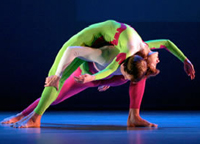
Site-Specific, Participatory Experiences
Join us for a Moment with the Merce Cunningham Dance Company on Saturday, May 19th: The Orange County Performing Arts Center celebrates the unique character of its new multi-venue Performing Arts Center Campus by presenting the remarkable Merce Cunningham Dance Company. The evening-length experience will feature company performances and multi-media happenings in multiple locations at the Performing Arts Center that will showcase the profound impact of this major American Artist.
7:00 PM – Samueli Theater: Bonnie Brooks, Dance Department Chair, Columbia College Chicago: “How to Watch a Cunningham Concert: Eight Entry Points and Three Exit Strategies”. Join dance scholar Bonnie Brooks as she presents the core concepts of the Cunningham Aesthetic in an informal lecture/demonstration that will demystify the Cunningham aesthetic for the newest audience members and deepen the experience for those who have seen the company in the past.
8:00 PM – Renée and Henry Segerstrom Concert Hall:
Merce Cunningham Dance Company performs an Event in the new Concert Hall. To celebrate this new space, the company creates a 30-minute, site specific performance. Musicians John King and William Winant will provide the sound component.
8:30 PM – Plaza Courtyard- ‘Beach Birds for Camera’: Adjacent to the new Richard Serra sculpture, view one of Merce Cunningham’s most important film dances, Beach Birds for Camera (1993, directed by Eliot Caplan), projected onto the wall of the Segerstom Hall at a majestic scale never seen before. The score will be performed live by John King, Stephan Moore, William Winant and Michael Dauphinais. While watching, visit one of the iPod stations to pick up your iPod Shuffle before you enter the next venue, Segerstrom Hall.

9:00 PM – Segerstrom Hall
The Merce Cunningham Dance Company performs Merce’s latest work, eyeSpace in the West Coast Premiere. Mikel Rouse has created an innovative score that incorporates the use of iPod Shuffles, digitally sampled sounds of John Cage’s prepared piano, and an environmental soundscape that will be performed live by MCDC musicians and projected throughout the theater. Decor and costumes are by Brooklyn-based painter Henry Samelson.
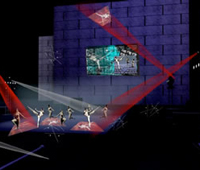
9:30 PM – Plaza Courtyard— ‘Playground-MinEvent’
It’s a “Happening!’ Return your iPod to the iPod Stations in the Plaza Courtyard and immerse yourself in ‘Playground – MinEvent; a one-of-a-kind Multi-Media Experience especially created just for tonight and just for you. This MinEvent will transform the Plaza Courtyard with dynamic projections, LIVE Cameras, music DJs, moving lights, and a cast of student dancers.
“Playground-MinEvent’’ is being created as a youthful Orange County 'response' to the ground-breaking work of Merce Cunningham and avant-garde composer, John Cage. Performers include UCI Dance students under the direction of Cunningham alumnus Michael Cole, plus student musicians/DJs, video artists and camera operators from Chapman University and Cal State Fullerton – all to create an Interactive LIVE Video/Soundscape full of surprises.
Posted by jo at 09:12 AM | Comments (0)
May 10, 2007
mech[a]OUTPUT
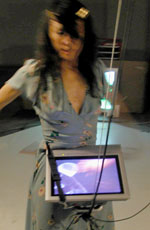
koosil-ja / danceKUMIKO
The Japan Society presents mech[a]OUTPUT by koosil-ja / danceKUMIKO :: Thu-Sat May 31- June 2, 2007.
Radical New York-based choreographer/dancer/ singer song writer/ new media artist Koosil-Ja presents an electrifying multimedia dance-performance with live 3-D environment, seamlessly incorporating elements of traditional noh music and choreography from the classic noh play Dojoji. The legends surrounding Dojo-ji Temple in Wakayama, southeast of Osaka, have inspired numerous noh and kabuki plays about the vengeful spirit of a spurned woman. By juxtaposing the restrained and subtle choreography of Dojoji with 3D world imaging projected on to a large screen, the daring Bessie Award and Guggenheim Fellowship-winning artist Koosil-ja transposes the work into her own aesthetic context, creating an innovative blend of modern and traditional, digital and flesh.
The production features 3D world designed and production by Claudia Hart, 3D Interactive interface designed and performed by John Klima, live Neo Punk Music by Geoff Matters, dramaturgy by Nanako Nakajima, Pendulum & Physical Apparatus Design and Kinetic Engineering by Michael Casselli, Head Gear by Tara Webb, and Betnon-C Bainbirdge (Video Projection Super Engineering).
With:
Geoff Matters (Live Neo Punk Music and Software Design)
Nanako Nakajima (Dramaturgy)
Michael Casselli (Pendulum & Physical Apparatus Design and Kinetic Engineering)
Claudia Hart (3D Wrold)
John Klima (3D Interface & Live Performance)
koosil-ja (Concept, Dance, Video, Video pendulum, Song, Sound Installation and Costume)
Tara Webb (Head Gear)
Benton-C Bainbirdge (Video Projection Super Engineering)
Dates: Thu-Sat May 31- June 2, 2007
Time: 7:30PM
Location: 333 East 47th Street, btwn 1st and 2nd Ave. NYC
Tickets: $25/$20 Japan Society members.
Reservations: Japan Society (212) 715-1258
at JAPAN SOCIETY Ticket Information
STUDENT RUSH $12.50 Student Rush (50% off!)
Pending availability, Student Rush tickets will go on sale an hour
before showtime. Valid ID required, 2 tickets max per ID.
mech[a]OUTPUT is made possible by a commission from Japan Society; funds from American Music Center Live Music for Dance, and New York City Department of Cultural Affairs; and generous individual contributions.
Posted by jo at 03:37 PM | Comments (0)
Synk
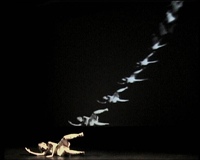
Real-time Processing
Synk is an experimental dance / video / audio piece where video and audio samples and recycles the movements of the dancer on stage, creating rich layers of images and sound. The performance deals with transformation of time ; distortion, displacement, delay, layering and buffering. The idea of Synk is that no prerecorded video or audio will be used, only material sampled during the performance are presented, to investigate live as raw material, and to impose a structure on a live situation to allow unpredictable results within that frame structure. Synk was made in 2002 and performed in a split-evening with the video ensemble 242.Pilots.
On Friday May 4th, (HC Gilje) performed Synk with Kreutzerkompani and Justin Bennett. More images from Synk (click on the small images).
Posted by jo at 02:32 PM | Comments (0)
April 24, 2007
Opensource: {Videodance} Symposium

Call for Proposals
The second international Opensource: {Videodance} Symposium :: Universal Hall Arts Centre, Findhorn Foundation Community, Morayshire, Scotland :: 21st - 25th November 2007.
Screen dance is a rapidly expanding area of artistic, academic and curatorial activity worldwide. Inherent in screen dance practice is the interface and collaboration between dance artists and media arts practitioners. Opensource: {Videodance} 2007 is an open symposium for video dance-makers and dance artists, academics, curators and producers coming together, to share ideas and work, network and debate, and provide a valuable platform for current issues in the area of screen dance practice to come to the surface.
Building on the strengths of the 2006 event, this symposium expressly aims to place current screen dance practice in a wider theoretical and critical context and to bring people from the collaborating disciplines together in a way that rarely happens, in order to impact significantly and positively on the lives and work of the participating individuals. The vision is to create an exciting and supportive place for people to engage, talk, hang out, relax, think, and listen, and to enable the spontaneous and dynamic unfolding of events. The programme for the four days will be a mixture of pre-arranged presentations and open forums initiated by the participants.
Whilst the greater part of the timetable will be dedicated to allowing the participants to initiate and following though discussion, we will again approach a select few artists/academics to give special presentations/lectures designed to inspire and provoke thought beyond the direct concerns of the participants. In addition, this year we are inviting proposals for limited number of presentations.
Call for proposals:
Seminar and Paper proposals are invited for presentation from authors (Academics and practitioners) of investigations into the interfaces of screen dance to one of the following formats: Academic research paper, Reports on practice-based work, Essay, Curated screening of work.
We encourage contributions that are related to all aspects of screen dance practice including interdisciplinary approaches in performance,
architecture, music, literature, visual arts, and new media but particular preference will be given to those exploring the outcomes of the first Opensource {Videodance} symposium in 2006, notably the "draft (hu)manifesto" available to read here.
All proposals will be peer-reviewed and selected based on their quality, originality, and potential for further discourse and appropriateness for the symposium. Paper Proposals/Abstracts should be submitted no later than June 30, 2007. Notification of acceptance will be sent by July 30, 2007. Those selected will be invited to submit their presentation for publication in the first issue of The Screendance Journal. email: abstracts[at]screendance.org
Due to the open nature of this symposium presentation slots are limited therefore we are interested in inviting speakers who will be able to engage fully with the wider aims of the event.
Produced by Bodysurf Scotland and Videodance.org.uk . Funded and supported by Scottish Arts Council and The School of Media Arts and Imaging, University of Dundee, Scotland, UK
Contact bodysurf[at]findhorn.com for booking details and to register interest and keep checking http://videodance.blogspot.com for bulletins.
Posted by jo at 07:09 PM | Comments (0)
April 23, 2007
Of Skins and Screens: Hyperdance, Haptic Cinema, and Contact Improvisation
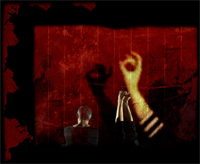
Somnambules
"...The browser window opens onto a nightmarish vision of death, disembodiment, and decay engulfed in the darkness of a black screen. Dancing specters and haunted souls—casualties of digital media—appear throughout Somnambules, a hyperdance piece. A small but growing genre of dance and new media, hyperdance [1] shifts the material conditions of dance creation and spectatorship by considering the computer screen a site for dance performance. Combining visual art, music, and dance by collaborating artists Nicolas Clauss, Jean-Jacques Birgé, and Didier Silhol, respectively, Somnambules emphasizes the computer user’s body in navigation and exploration. The user’s motion, confined as it is to the small geographies of mouse or trackpad, and the user’s physical contact with the image, similarly confined, stand out in this piece as compared with other hyperdances. [2] Users affect onscreen motion through their own movements, which operate simultaneously with qualities of touch (click, drag, mouse, etc.): motion and touch work in tandem at the mutually-defining sites of the user’s body and the image. Drawing attention to the piece’s cinematic and choreographic components, I explore movement and touch as both objects of interaction and means of interaction in Somnambules. I further tease out specific modes of bodily interaction, working toward a more nuanced understanding of bodily engagement in the broader fields of interactive and responsive media..." From Of Skins and Screens: Hyperdance, Haptic Cinema, and Contact Improvisation by Harmony Bench, Extensions Journal.
Posted by jo at 10:05 AM | Comments (0)
April 19, 2007
The Reception

Performance + Discussion
A tele-immersive cross-disciplinary performance piece called The Reception will be presented April 20, 21, 27, 28 at 8pm and April 22, 29 at 2pm as a part of the Berkeley Dance Project 2007. The piece was created by the co-directors of SmithWymore Disappearing Acts, Lisa Wymore and Sheldon B. Smith in collaboration with Ruzena Bajcsy of CITRIS (Center for Information Technology Research in the Interest of Society). Live performance and streamed realtime 3d tele-immersive technology are used to poetically examine the subject of presence. BDP is an annual collection of danceworks presented by UCBerkeley's Department of Theater Dance and Performance Studies. Performances will take place at UCB's Zellerbach Playhouse theater.
The April 22 performance will be followed by a post-performance discussion: Being Here: Presence/Remote Presence within Live and Media Based Performance by N. Katherine Hayles. The discussion will feature a demonstration of a live bi-located dance utilizing the tele-immersion labs at UC Berkeley and the University of Illinois, Urbana-Champaign. Co-sponsored by the UC Berkeley Department of Theater, Dance, and Performance Studies, the Towsend Center Dance Studies Working Group, and the Dance Department and Intermedia Program at Mills College. The discussion is free and open to the public.
Posted by jo at 07:40 PM | Comments (0)
The Reception

Performance + Discussion
A tele-immersive cross-disciplinary performance piece called The Reception will be presented April 20, 21, 27, 28 at 8pm and April 22, 29 at 2pm as a part of the Berkeley Dance Project 2007. The piece was created by the co-directors of SmithWymore Disappearing Acts, Lisa Wymore and Sheldon B. Smith in collaboration with Ruzena Bajcsy of CITRIS (Center for Information Technology Research in the Interest of Society). Live performance and streamed realtime 3d tele-immersive technology are used to poetically examine the subject of presence. BDP is an annual collection of danceworks presented by UCBerkeley's Department of Theater Dance and Performance Studies. Performances will take place at UCB's Zellerbach Playhouse theater.
The April 22 performance will be followed by a post-performance discussion: Being Here: Presence/Remote Presence within Live and Media Based Performance by N. Katherine Hayles. The discussion will feature a demonstration of a live bi-located dance utilizing the tele-immersion labs at UC Berkeley and the University of Illinois, Urbana-Champaign. Co-sponsored by the UC Berkeley Department of Theater, Dance, and Performance Studies, the Towsend Center Dance Studies Working Group, and the Dance Department and Intermedia Program at Mills College. The discussion is free and open to the public.
Posted by jo at 07:40 PM | Comments (0)
March 10, 2007
Other Stories

An Evening of Interactive Arts
Other Stories is an evening of interactive arts at the School of Interactive Arts & Technology, Simon Fraser University’s Surrey Campus :: 14 March, 2007 at 7pm :: The project will be streamed live.
‘Other Stories’ is a work in progress showing of a research project into motion capture, dance, and ethics. This project explores the strangeness of captured human motion. It is a live performance with two dancers in a Vicon motion capture system, the 3D computer tracking system most commonly used for creating video game avatars. Instead of building recognizable human shapes, the essence of movement is conveyed with dots, sparks, and lines, dissolving the human form but maintaining a sense of play, of pathos, and of bodies. When virtual bodies meet real bodies, which ones are the others? The stories are of grandmothers and angels, of fireflies and knitting.
The motion capture performance is a collaboration between Susan Kozel, Greg Corness, and visiting dancer/researcher Inka Valipakka; additional artistic content provided by Maia Engeli, Camille Baker, Jack Stockholm and Tamara Smyth.
The performance is supported by SFU’s President’s Research Grant and by the Academy of Finland. It is a co-production of The Escape Artists Society (TEAS) and Mesh Performance Partnerships.
Other events the same evening include:
4- 6pm: lecture by Professor Sha Xin Wei of the Topographical Media Lab, Concordia University (part of the SIAT Research Colloquium speakers’ series): room 3280
6-7pm: refreshments and undergraduate student installation projects in the campus mezzanine
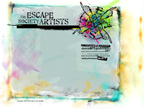
How to get there: the easiest way is to take the Sky Train (Expo Line) to Surrey Central and walk 200 ft to the tall green building, SFU Surrey Campus is at the foot of the tower. For more details and driving instructions see http://www.surrey.sfu.ca/about/maps.html
Please contact Camille for more information, to request an interview, and/or to find out more about covering the event at camille[at]escapeartists.ca
The Escape Artists Society (TEAS) presents "other stories" capturing motion, telling tales, spinning yarns… (free for TEAS members showing membership). For more information on T.E.A.S. go to http://www.escapeartists.ca
Posted by jo at 04:41 PM | Comments (0)
February 28, 2007
turned
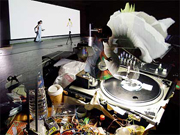
Resampled Dancer
Dance MADE IN BAVARIA 1. - 3. March 2007 Munich :: Chris Ziegler: turned + Herzliche Einladung nach Munchen in die Muffathalle, 2nd March 2007 8:30 PM :: director/ video: Christian Ziegler (D) / dance: Kazue Ikeda (J) / music: FLorian Meyer (D).
turned is an interactive and multi-media dance performance, developed and performed by media artist Chris Ziegler from Munich, with Kazue Ikeda, a Japanese dancer currently working in Berlin and DJ Florian Meyer (Institut fuer feinmotorik). The performance combines elements from dance, painting, visual art and music. The recorded images of the dancing body are sampled and distorted by electronic processing. The motion deconstructed in this manner opens up a poetic vision of loss and destruction. The viewer is taken along on a quest for clues. The piece turned is a turntable: it begins as a concert, continues as dance and then turns into an interactive video sequence and finally into a VR-installation - a multi-media-based spatial structure evolving before the eyes of the viewer.
The production realized during a residency at ZKM | Karlsruhe (center for art and media) was supported by: Kulturreferat der LH M|nchen, Bayerischer Landesverband Zeitgenvssischer Tanz, Fonds Darstellende K|nste e.V., Bonn.
Posted by jo at 11:05 AM | Comments (0)
February 14, 2007
Temporal Interference
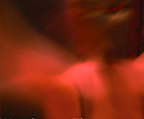
An Exploration of Space and Memory
Temporal Interference: Jane Franklin Dance explores the space memory occupies in a collaboration with digital artist Bryan Leister and composer Gina Biver. This time based performance installation can be seen at Warehouse Theater during two weekends, February 24 - 25 and March 3 - 4. The concept is to explore aspects of space and memory, and how it can effect those around us. Using live video, electroacoustic software and a Theremin, dancers will carve out an environment of sound and color. Biver's compositions will be reinterpreted as the dancers move through space, creating a unique experience of media and modern dance. The media installation will be available for audience interaction between performances.
There will be three performances each day, and will feature several dancers, live video, sound and interactive sculptural elements. For advance tickets and more information visit: http://bryanleister.com/ti/ Read a review >>, and another.
Posted by jo at 11:24 AM | Comments (0)
February 08, 2007
My First Second Life Dance Performance
On Sunday night, while watching the Super Bowl, I attended the premiere performance of Second Life Ballet's "Olmannen" in the Second Life virtual world. I wrote about this upcoming performance last week.
Well, I had to give myself a crash course in Second Life to attend this performance because I've never experimented with this virtual environment. But just about everything went wrong on the computer and software side for me, which I'll explain more about below.
But first, here is background about the Second Life Ballet performance so you can have an idea of what an avatar dance performance is like:
- The program guide for the performance of "Olmannen: An Original Ballet."
- A news piece from OspreyTherian, uploaded to YouTube, recaps the Sunday night performance. You can see the dancers in the background for a few seconds, which gives you a glimpse of what dancing is like in this virtual world: More >> [blogged by Doug Fox on Great Dance]
Posted by jo at 07:29 PM | Comments (0)
February 07, 2007
V2_Lab presents

Test_Lab--Dancing-around-technology
Test_Lab: Dancing around technology (presentation) :: February 22, 2007 20:00-23:00 :: admission: free :: reservation: press[at]v2.nl.
Over the last decades, most artistic disciplines have been introduced to technological developments. In many artistic fields, the technologies introduced have been fully integrated in the artists' daily practices resulting in an integration that often makes it hard to imagine the field ever existed without them. However, in the field of performing arts (physical artistic expression such as dance and theatre) this integration did not evolve as naturally. Although many attempts have been made at adopting new technologies in these fields, the marriage between the two was often forced, resulting in what was rather a combination of technology and performing arts than integration of the two.
One of the main aRt&D themes of the V2_Lab is the development of sensor and actuator technology for the fields of performing arts and human-machine interaction. This Test_Lab aims to bridge the different needs of and approaches to technology between performing artists and soft-, hardware designers. This will be realized in this edition of Test_Lab through the testing of two projects that are currently under development in the V2_Lab; Soft(n) and Body In Bits And Pieces. A theoretical presentation by Armando Menicacci will further elaborate on the theme. Both the two projects and the presentation are described below. Soft(n) is the working title for an interactive public art-experience developed in a collaboration between Thecla Schiphorst (Director of the Whisper[s] research group, School of Interactive Arts and Technology, Simon Fraser University, Vancouver) and V2_Lab, within the framework of the Passepartout consortium.
This project is based on exploring emerging network behavior through interaction between a group of soft networked objects. It takes place in a social urban setting; a café or lounge. The work incorporates the design of a group of interactive soft objects, each containing a specially designed and custom-engineered multi-touch soft input surface, motion detectors, an ability to output movement (vibration), light, sound and physical deformation, and communicate wirelessly to each other. The project includes the development and testing of an interaction model based on input heuristics of touch and movement. An earlier version of the project recently won the Gold Exhibition Award at the ITEA 2 symposium.
Body In Bits And Pieces (BIBAP) is an interactive Internet project initiated by Carolien Hermans (Director of DansLab, Amsterdam) and is funded by the Nederlandse Omroep Stichting (NPS) and the Stimuleringsfonds voor Nederlandse Omroep Producties. A prototype of the project was developed in collaboration between Danslab (Carolien Hermans and Benjamin Scheers) and V2_Lab. The aim of the project is to integrate a dance movie in an interactive Internet application and to create an interface that requires physical interaction to enhance the immersion of the user. The project combines physical expression in two ways; by cleverly integrating dance movie clips in the application and by enabling control over the application by body movement of the user. Armando Menicacci is the director of MediaDanse (University Paris-VIII / ANOMOS, Paris). Menicacci will present how the body movement analysis theory and practice developed in University Paris-VIII lead to new relationships between dance and digital technology in some contemporary artworks and fundamental researches created and conducted by his research group. By doing so, he will show how MediaDanse forms a structure of exchange between the fields of academic and technological research, networks of artistic creation, cultural action, and the general public.
Test_Lab is a bi-monthly public event hosted by V2_ (Institute for the Unstable Media, Rotterdam)
Related links:
ANOMOS: www.anomos.org
Whisper[s] research group: whisper.surrey.sfu.ca
Dampf_Lab: dampf.v2.nl
V2_Lab: lab.v2.nl
Posted by jo at 10:55 AM | Comments (0)
February 01, 2007
Quartet

Virtual Dancer
Quartet :: 15 Feb 2007 - 18 Feb 2007 :: The Great Hall at Barts :: Informed by new scientific research in the field of physiology, this ICA co-production is the culmination of several years' collaborative research. It is an investigation into the kineasthetics of music: determining movements which produce sounds, which in turn produce new choreographies.
Movement is played across the senses of the human body. On stage at the Great Hall at St Bart's hospital live music and dance come together in the form of a virtual dancer that is driven by the mechanics of physical expression. This multi-media interplay is the culmination of several years collaborative research from specialists from engineering, biomedical and computational science, 3D animation and motion control in the field of physiology. Three leading choreographers - Lea Anderson, Russell Maliphant and Lisa Nelson - will each shape sections of the performance.
Quartet has 4 components: a virtual dancer; a musician; a robot camera; and, a real dancer. Quartet's central figure, the virtual dancer, is an avatar of sensual information, playing between its manifestation and its puppeteers. On stage the interactions between the human and computerised performers slip through different pairings, trios, and quartets, such as the musician using the speed or acceleration of her violin playing to duet with the real dancer; or a trio between the real and virtual dancers and the robot camera, exploring the choreography of cinematic space: the poetics of looking and moving. This interplay uncovers the tensions within the transfer of data.
The performance experiments with our perception and its articulation. It demonstrates communication within and between bodies in real-time by creating relationships between music, the gesture of musical performance, dance, robotics and animation.
Quartet has been funded by Sciart Production Awards 2005-6 for the Wellcome Trust in collaboration with the Physiological Laboratory at Cambridge University and the Arts Council of England. It is co-produced by the Live and Media Arts Department at the Institute of Contemporary Arts, London, with support from the Australia Council for the Arts, Arts Victoria, and ZKM Center for Art and Technology, Germany.
£15 / £10 Concessions / £9 ICA Members.
To book tickets please call the ICA box office on 020 7930 3647, open between 12noon and 9.00pm daily. Alternatively go to the ICA web site http://www.ica.org.uk/Quartet+12978.twl
Quartet Talk :: 17 February 2007 :: ICA Cinema
The creators of Quartet, specialists in dance, music, computational science, 3D animation and motion control, will discuss the creation of the software and hardware for its new interactive systems.
The discussion will be chaired by Margie Medlin, Project Director and Dr Susanna Ackers from the Hartware MedienKunstVerein, Dortmund, Germany.
Stevie Wishart Musical Director and Composer & Todor Todoroff, Sound and Gesture Systems Engineer will speak about creating real-time musical instruments to map the sounds and gestures of the musician to a virtual dancer.
Lea Anderson, Choreographer, Gerald Thompson, Motion Control Camera Designer & Carlee Mellow, Dancer will speak about working with motion control technologies to create choreographies of cinematic space and dialogues that uncovers the tensions within the transfer of data.
Nick Rothwell, Interface Designer and Systems Development & Holger Deuter, 3D character designer will speak about creating a versatile and flexible creative system for experimenting with cause and effect in multiple media.
£6 / £5 Concessions / £4 ICA Members.
** SPECIAL OFFER SPECIAL OFFER SPECIAL OFFER SPECIAL OFFER SPECIAL OFFER SPECIAL OFFER SPECIAL OFFER SPECIAL OFFER**
The first 20 people to book tickets for this talk will be able to purchase 2 for 1 tickets for a performance of Quartet (subject to availability). Offer only available via telephone bookings: call the Box Office to book on 020 7930 3647.
Emma Quinn
Director of Live and Media Arts
ICA
Visit the new ICA website www.ica.org.uk
Posted by jo at 08:21 AM | Comments (0)
January 24, 2007
RPM's Remixed
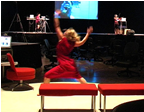
A Virtual Space "Sings"
RPM's Remixed is a telematic, transdisciplinary performance based on remixing Alvin Lucier's RPM's score – integrating dance, video and sound improvisation between artists in New York, Tampa, and San Jose.
Alvin Lucier, a well-known composer of music and sound installations that explore natural phenomena and resonance, is renowned for making spaces "sing." This piece explores the possibilities of using one of his scores to make a virtual space "sing" by using improvisational techniques as well as the natural feedback and delay created by streaming.
Themes exploring isolation, intersection, and madness reverberate through images, body and sound. Dancers and sound artists in San Jose, Tampa, and New York collaborate while realtime processing of the video images is driven partially by the performers’ movements. Motion analysis is sent over the network to trigger aspects of video manipulation, further blurring the lines of authorship and contributing to the impromptu chemistry.
Lucier’s original “RPM’s” score was a tongue-in-cheek take on creating sound based on depressing and releasing the accelerator of an Aston Martin engine. The score itself is a series of nonsensical curvatures and dashes – nonsensical, that is, until a personal interpretation of each written gesture is applied.
Taking this a step further, the cast of RPM’s Remixed deconstructs the score, into dance gestures, violin strokes, guitar riffs, and sound and video mashing. The challenge is not only to collaborate within one’s own medium but to improvise successfully between mediums and within a virtual space. Can the magic of improvisation reach across the ether? [via Rhizome]
Posted by jo at 09:33 AM | Comments (0)
January 18, 2007
Anna Halprin: Dance/Art Experiments

Lecture and Workshop
Graduate Lecture Series presents Anna Halprin: Dance/Art Experiments :: January 31, 2007 from 12:00 PM to 2:00 PM :: USC Roski School of Fine Arts / Watt Hall 104, 3001 S. Flower St., University Park Campus, Los Angeles, CA 90089-0292 :: Telephone: 213.740.2787 /Fax: 213.740.8938 :: more info: slockhar[at] usc.edu
Anna Halprin has been working in the field of dance since the late 1930's creating revolutionary directions for the form and inspiring fellow choreographers to take modern and post modern dance to new dimensions: from theatrical production, to teaching, to improvisation, to celebrations of modern ritual and myth, to environmental and street dance, to multi-cultural collaborations, and dances fostering audience participation and creativity. Among her students were Trisha Brown, Simone Forti, Yvonne Rainer, Meredith Monk, and Robert Morris. Halprin pioneered what became known as "postmodern dance," creating work that was key to unlocking the door to experimentation in theater, music, happenings, and performance art.
"What are the possibilities for merging dance, art, and life?" In a special hands-on lecture/workshop, students will learn about Ms. Halprin's groundbreaking work in dance and education, then have the opportunity to participate in the creation of a dance-art experiment. The lecture will be followed by a workshop from 2-5 p.m. in the Roski MFA Gallery. The workshop is open to USC fine arts and dance students and others by special arrangement. Participants should bring a lunch and a scarf, and wear comfortable shoes & clothing. Please call 213.743.1804 for more information.
This event is co-sponsored by the USC Roski School of Fine Arts MFA Program and the Dance program at the USC School of Theatre.
Posted by jo at 05:38 PM | Comments (0)
Alan Sondheim
Incidences rehearsal transformed into community of problematic nodes. Recorded and transformed Geneve and New York 2006-7. A tape of enumeration and Heisenberg; particles and participants appear and disappear. [via netbehaviour]
Maud Liardon, Geneve, Sw. modification of space.
Posted by jo at 03:27 PM | Comments (0)
Schwelle
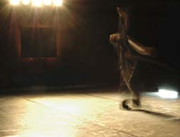
@ Tesla/Transmediale 2007
Schwelle is a new media and performance project using cutting edge acoustic and interactive technologies to explore the extreme threshold states of consciousness that constitute human experience. The multi-part project uses High Definition image and multi-channel sound, interactive installation and live performance to create states of consciousness in the spectator akin to the thresholds states that one experiences at the edge of trance, sleep and death. For transmediale '07, Tesla presents parts 1 and 2.
Part 1 is a turbulent exploration told by way of image and sound of the experience undergone at the time of the dissolution of the body and of consciousness. Part 2 is a live performance in which the audience confronts a lone single performer Michael Schumacher, master improviser and long time dancer by William Forsythe’s Frankfurt Ballet, experiencing the traumatic transition period between death and rebirth. Utilizing wireless sensor networks in the room and on the dancer’s body, Part 2 creates a stage environment where light, sound and objects take on their own choreography, performing with Schumacher, breathing, and behaving alongside him. Where does the body end and the room begin? What happens in the threshold where body and room merge, mutually influencing and transforming each other?
Schwelle is a co-production between artists and researchers from cultural and scientific institutions in Canada, China, Germany, Holland, China, and the USA. Schwelle, Part 2 was partially developed during a project residency at Tesla in Summer 2006 and will receive its world premiere at "tesla zur transmediale".
Part I
Concept/Direction/HD Video/Sound: Chris Salter
Collaboration Sound: Daniel Moody-Grigsby and Philip Viel
Part II
Premiere: Tesla/Transmediale 2007, Berlin, February 2007
Concept/Direction: Chris Salter, in collaboration with Michael Schumacher
Dramaturgy: Heidi Gilpin
Lighting Design: Lea Xiao
Sound Design and Programming: Marije Baalman, Daniel Moody- Grigsby, Chris
Salter, Philip Viel
Interaction Design/Sensing Systems: Marije Baalman
Objects: Thomas Spier, Flora Luna
Production Stage Manager/Technical Director: Daniel Plewe
Production Assistents: Daniel Wessolek, Alexander Wilson, Brett Bergmann
Tesla: Medien-Kunst-Labor, Klosterstrasse 68, Berlin
Thursday-Saturday, February 1-3, 2007. 20:30
For tickets/more information, please visit http://kasse@tesla-berlin.de
Christopher L. Salter, Ph.D.
Asst. Professor of Computation Arts
Faculty of Fine Arts
Concordia University
Researcher_Interactive Performance and Sound Hexagram
Posted by jo at 03:00 PM | Comments (0)
January 15, 2007
37 Isolated Events
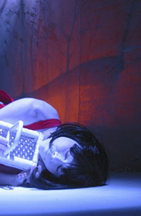
Contemporary Butoh Dance and Immersive Video Performance
37 Isolated Events: a Contemporary Butoh Dance and Immersive Video Performance :: Thursday January 18, 2007 - 7pm :: San Francisco Asian Art Museum :: free w/ $5-after 5 pm museum admission.
Blindsight Artistic Director/Choreographer Paige Starling Sorvillo collaborates with Los Angeles-based media artist Lucy H G and UK-based Australian composer duo imaginationandmymother.
this ocean is also the desert and I am walking into a minefield, into this installed landscape this land no longer part of the soul, I swallow, I listen, I can see your body cut into foreign lands.
37 Isolated Events begins with the normal running temperature of the human body and gradually fabricates a facsimile body. Within the noise of networked society, our intimate distance and distant intimacy induce a virtual, mediated sensibility. We are anesthetized - our breath mechanized - as the human biological system becomes hybridized with the global system. At thirty-seven degrees Celsius, in isolation, we have unprecedented potential to risk exposure and make contact inside the noise of a growing global network.
concept/direction | paige starling sorvillo
collaborating media artist | lucy hg (LA)
sound artists | imaginationandmymother (UK)
performance/choreography | sorvillo, monique goldwater, isabelle sjahsam, jez lee
lighting design | elaine buckholtz
photography | ian winters
San Francisco Asian Art Museum :: 200 Larkin, Samsung Hall (Civic Center BART)
37 Isolated Events is a supported in part by the Zellerbach Family Foundation and Asian American Dance Performances. Paige Starling Sorvillo is honored to be a 2007 CHIME awardee with Marc Bamuthi Joseph.
Posted by jo at 12:22 PM | Comments (0)
January 11, 2007
‘SPIRAL’ by Kyoko Nagashima
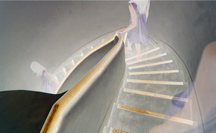
Reviewed by Yukihiko Yoshida
[Posted by Yukihiko Yoshida] ‘SPIRAL’ by Kyoko Nagashima; text by Yukihiko Yoshida (dance performance critique)
A girl begins her move slowly as the audience is adjusting their view. It is a wonderland beyond image, and it looks reachable but nobody could even touch. An illusion opens up before my eyes like when I see contemporary dancers dancing. I saw this work of Kyoko Nagashima at Gallery 360°. An ordinary girl moves slowly in the video created by a lenticular lens. Watching ‘SPIN’ and ‘RHYTHM’ displayed in the gallery, I had to stop and stare at them for a while, because I felt there was something common to contemporary dance performance.
‘SPIRAL’ and ‘BATON’ are displayed in the current show. ‘SPIRAL’ is about politics, balance, and co-existence in everyday life. A girl is only climbing up the stairs. She stops slowly, starts off, sits down, and vanishes gradually…she keeps walking in the screen. Time passes quietly in the fantasy world of images. The picture of the girl is taken by a lenticular lens, and put in the panel to be displayed.
Kyoko Nagashima says that she has been asked often if she is interested in dance performance since when she presented the work by using a lenticular lens. She worked on visual images from the beginning, and in the process of revising them to a flat level, she came up with the idea of using a lenticular lens. She recently watched the film directed by Tatsumi Hijikata and went to see the performance by Pina Bausch. The girls in her works seem to have similar personalities with those dancers like Kaoru Uchida, Natsumi Tokoro, and Hiroko Fuchizawa from Roussewaltz who is fashionable, or HO HO-DO, a dance duo who is charming and friendly, or modern contemporary dancers like Satoko Yahagi and Hisano Yamanaka, who remind us of Alice in a big city (ex. in Yahagi's work,"Alicetopia"), or Chizuru Inagawa who shows off cute, but transparent sense of being. The girls are not dancers in Nagashima’s videos, but they are models whom people do not recognize. She says that she is interested in the feeling of the presence of a person. ‘Existing’, ‘being there’, ‘standing there’…out of this query, her creation is made somewhere where a link to reality is missing. The human figure in the video moves slowly and sits down. Then, the same person reappears, overlaps with the past image, and goes off to the side.
This kind of portrait of human being looks unreal and it has something in common with stage lighting. Like a photograph inverted by solarization, when an image is overlapped with another, unrealistic world is opening up in front of your eyes. ‘BATON’ (2006) is presented for the exhibition entitled A-LUNCH. This is a unique project in such a way that a waiter delivers an artwork to a customer at the table. Her artwork is in a box like a jewelry box delivered to the table. Open the box to find a portable device. It seems that Kyoko Nagashima is interested in the history of visual culture in a broader sense. A girl is standing ordinarily in the screen of the portable device, slowly lifting up her elbow to bend her arm, at the next moment, she is swiftly strolling away. The timing or an empty moment of her move tend to grow longer without any excitement, and it reminds me of the contemporary dance performance by Mariko Okamoto of "sputnik*gilu". The idea of this video is to hand over a baton to a viewer from inside the screen. There is no sense of relaying a baton in there. Images overlap one after another. A fantasy world and slowly passing time are continuing on in the small device on the palm of a hand.
Kyoko Nagashima once published booklets entitled, ‘ROUND’ and ‘WINK’ (1997), which focus on human motions of moving legs and blinking. At this early stage of her career, she tried to deal with the ‘phenomenon of someone being there’. This idea made her to create ‘DOOR’, ‘SPIN’, ‘RHYTHM’(2005), which portray a girl in everyday life in an imaginary building or a gymnastic hall. In ‘DOOR’, a girl is standing still in front of the door. In ‘RHYTHM’, ribbons are laid all over the floor of the gymnastic hall, and it gives the image of rhythmic gymnastics. It will be no exaggeration to say that this video evokes dance or performance. In reality, when Kyoko Nagashima composes moves for the model to do, she has the images in advance. ‘Two most important factors are open space and its corresponding moves,’ she says. Each move is absolutely natural in the context, and she never gives a meaning to it, according to her. The moves happen spontaneously on the spot and she shoots. This attitude is found in professional dancers and choreographers as well. The finished images are transferred in the form of a panel.
She studied oil painting at school and did drawing of human bodies on iron. Iron is a hard material, but it is something that rusts and decays to her. It is just like a human body. She used to take photographs of human bodies just for the record as a part of making artworks, and this is how she becomes a visual artist. It is a sincere fact that she cannot be categorized merely in a video artist or a fashionable boom. She is more than that. Unfortunately the overall tone underlying her work gives a vague impression whether she is willing or not, because the image that she creates could be regarded as just another nostalgic picture in our mind. She will need to take one step further to impress herself as an artist in this world. (At Gallery 360°4th August,2006)
Kyoko Nagashima:
tokyo-artists kyoko nagashima art works http://www.tokyo-arts.jp/kyokonagashima.html
Cf. Related Japanese Dance Artists
Roussewaltz:
http://www.tokyo-arts.jp/kyokonagashima.html
Satoko Yahagi and also Hisano Yamanaka, Satoko Yahagi "Alicetopia" and Mariko Okamoto "sputnik*gilu" http://www.turbulence.org/blog/archives/000660.html#comments
Ho-Ho-Do
http://hoho-do.net/
Posted by jo at 09:23 AM | Comments (0)
December 19, 2006
Dance and Process
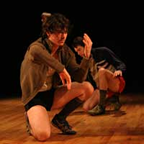
New Work
Dance and Process: Daniel Linehan, Melanie Maar, and Jillian Peña :: The Kitchen :: Wednesday, December 20, 8pm; Thursday, December 21, 8pm :: Tickets $10 :: Curated by Miguel Gutierrez ::
The culmination of a seven-week group process of sharing work and receiving structured feedback, this evening features new work by choreographers Daniel Linehan, Melanie Maar, and Jillian Peña. In Human Content Pile, Daniel Linehan probes his own choreographic process from an objective and amoral perspective in order to create a structure based on the incessant daily accumulation of material. Linehan collaborates with dancers Anna Carapetyan, Natalie Green, Michael Helland, and Miriam Wolf, along with Minneapolis-based writer/composer Erik Belgum, who provides a text-based score. Choreographed by Melanie Maar, DOPA - Duo in Process translates the symptoms of a body with neurological dysfunction into the arena of choreography and performance. Two women relate in an environment where the interplay of conscious and subconscious triggers stimulate their bodies to move. The performers are Mariangela Lopez and Maar, and a sound collaboration with Dylan Stanfield. In search of transcendence, Jillian Peña invites the audience to The Promised Land--an imaginary landscape of dreams and opportunities. The Promised Land is an interactive video experience.
Box Office: 212-255-5793 ext. 11. Box Office Hours: Tue-Sat, 2-6pm
The Kitchen is located at 512 West 19th Street between 10th and 11th Avenues.
Subway: A, C, E to 14th Street; 1 to 18th Street; L to 8th Avenue.
Posted by jo at 08:41 AM | Comments (0)
November 21, 2006
The Kitchen presents
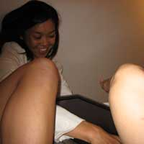
Dance without Bodies
Koosil-ja's Dance without Bodies :: The Kitchen :: Dec 6-9 (Wednesday-Saturday) 8pm :: Tickets $12.
Dance Without Bodies is a new, commissioned, dance and multi-media performance by Bessie award-winning choreographer Koosil-ja that questions the fundamental role of “presence” in performance and forges new relationships among dancers, technologies, and the audience. In this new work, two dancers move between the space of the stage and that of video projections, performing simultaneous yet spatially disconnected solos for an audience seated in two separate areas, situated back-to-back in the theater. Created through her “live processing” performance method, which she developed with dancer Melissa F. Guerrero and Geoff Matters (music, video, and software design), the performance is different each night, as the movement in the work is neither strictly set choreography nor pure improvisation. Rather, the dancers generate their solos nightly, in real-time, in response to the action depicted on three different videos, which are randomly combined each evening on clustered sets of monitors. The piece also includes lighting design by Jane Shaw, video design by Benton-C Bainbridge, and graphic design by Pascale Willi.
Box Office: 212-255-5793 ext. 11. Box Office Hours: Tue-Sat, 2-6pm
The Kitchen is located at 512 West 19th Street between 10th and 11th Avenues.
Subway: A, C, E to 14th Street; 1 to 18th Street; L to 8th Avenue.
Posted by jo at 04:57 PM | Comments (0)
November 13, 2006
String Beings
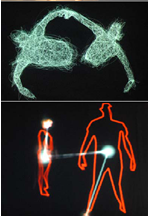
Manipulating and Manipulated
String Beings is the result of an exciting collaboration between Snappy Dance Theater, Jonathan Bachrach, Lucia Lin and Berlin composer Michael Rodach exploring the subject of manipulation through the interaction of multiple media. “String Beings” explores the relationship between manipulating and being manipulated, using a variety of metaphors ranging from the literal (individuals playing string instruments, individuals being pulled by strings) to the complex (dancers manipulating musicians, dancers manipulating images created through their interaction with technology, technology manipulating the audience by transforming reality into a “new” and projected reality). Snappy's physical style and artistic approach of using irony as an essential tool of expression even for complex or sometimes serious topics blends well with Jonathan Bachrach's ability to turn a profoundly human dance expression into a paralles univers of doubt, deception and surprise.
“String Beings” will be a compilation of several sections that alternate interactions between musicians and dancers, dancers and technology, and all three elements. The musicians will be part of the choreography to such an extent that at one point, Lucia Lin will be integrated into the acrobatic movement while playing the violin. Berlin composer Michael Rodach created the 60-minute sound score for The Temperamental Wobble in 2004 and will compose “String Beings” to be a mix of electronic music with live strings.
At the Cambridge Multicultural Arts Center :: November 17th & 18th at 8:00 pm :: 41 Second Street, Cambridge, MA :: Tickets.
Approximate Length: 40 minutes (one half program)
6 dancers, 3 musicians (2 recruited locally), 1 computer artist
Choreography: Martha Mason/Snappy Dance Theater
New Media Artist: Jonathan Bachrach
Violin: Lucia Lin
Set Design: Chris Fitch
Lighting Design: Joseph Levendusky
Music: Michael Rodach
Founded in 1997, Snappy Dance Theater is led by Co-Founder and Artistic Director Martha Mason. "Snappy" has grown to become the most active contemporary dance company in Massachusetts, and has the 12th largest audience of all performing arts organization in the Boston area. Snappy has been presented in 18 U.S. states and 4 international countries; has received critical acclaim in major publications (The New York Times and Dance Magazine); and has received major commissions including Bank of America CelebritySeries commission of The Temperamental Wobble in 2004,
presented at the Cutler Majestic Theater. Snappy's mission is inspire audiences and to make dance and theater more accessible to people of all ages and backgrounds.
Jonathan Bachrach, Ph.D. is an artist and research scientist at the MIT Computer Science and Artificial Intelligence Lab. He researches robotics, sensor networks, programming languages, and new art making platforms. Bachrach's artwork has been shown at the MIT Media Lab, Dance Theatre Workshop (NY), Eyebeam Gallery (NY), at several Boston galleries, and at Festival du Nouvelle Cinema in Montreal. In collaboration with Dan Paluska and Brian Knep, Bachrach leads the Collision Collective and curates exhibitions of art technology with MIT and Boston-based artists.
Lucia Lin has been a prizewinner of numerous competitions, including the 1990 International Tchaikovsky Competition in Moscow. She has performed in solo recitals throughout the U.S., making her New York debut at Weill Recital Hall in 1991, and has appeared with the Boston Symphony Orchestra, Boston Pops Orchestra, St. Louis Symphony Orchestra, Oklahoma Symphony, Cincinnati Chamber Orchestra and Festivalorchester in Graz, Austria. Lin is a member of the Muir String Quartet, and a founding member of the Boston Trio and the chamber group, Innuendo.
Posted by jo at 02:03 PM | Comments (0)
October 31, 2006
Klaus Obermaier
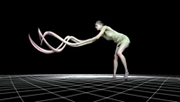
Le Sacre du Printemps
Media-artist, director and composer Klaus Obermaier has created a new performance of Russian composer Igor Stravinsky’s classical ballet Le Sacre du Printemps. In Obermaier’s version, the classical ballet is expressed in the form of an interactive music, dance and 3D project.
On stage distributed stereo-cameras and a complex computer system transfer the dancer Julia Mach into a virtual three-dimensional space. Time layers and unusual views overlay and multiply themselves and enable a completely new perception of the body and its courses of motion. Real-time generated virtual spaces communicate and interact with the dancer. By means of 32 microphones the entire orchestra is integrated in the interactive process as well. Musical motifs, individual voices and instruments influence the form, movement and complexity of both the 3D projections of the virtual space and those of the dancer. As such, music is no longer only starting point, but also completion of the choreography.
Klaus Obermaier’s version of Le Sacre du Printemps was performed first at this year’s Ars Electronica Festival in Linz, Austria. [blogged by Lene Mailund on Digital Experience]
Posted by jo at 02:56 PM | Comments (0)
October 20, 2006
Ah-ha: Narrative Structures in Reactive and Interactive Video Art

Connecting the Physical and the Digital
[Image left: "Guillotine" by Steve Shoffner) "Performance is so many things: the synchronized sounds of a symphony; actions with words in a play; steps and turns in a dance; words from a pulpit. Performance art, too, is variable, perhaps too multifarious to define, even with semicolons. At traditional performances with traditional support materials, from symphonies with program notes to theatre productions with playbills, performance acts as replay, a repeat of an event, a memorization of a string of notes or a set of lines, a reformulation of a tested formula. Then there are those performances that vary, that respond to the moment, that unfold through the implementation of chance or improvisation or, more and more, digitization. With the insertion of new technologies into performance, the question arises – do actions result from numbers? What indeed is the connection between the physical and the digital? Does the digital component determine the performance, or do actions generate a numeric pattern, which then underlies the piece's structure?
The aesthetic and conceptual import of digital performance pieces is linked to the ordering of a piece's technological components. Random sequencing is one form of structuring immersive environments or data-triggered scenes. Fixed sequencing of scenes, with a predetermined index of performed actions and triggered events, follows a preset score. Alternately, sensory responsive improvisation is flexible and often produces variations in structure. In each case, the piece's content is the result of a digital system: programming or computer responses to external stimuli determine how the performance plays out. Even interactive improvisation, in which a human action triggers a computerized event, is a digital system, albeit one that emphasizes the human element, or input, in that system. The content of an interactive piece is closely related to its structure – the interaction between trigger, whether generated by the viewer or performer, and event. Interesting variations in content emerge when the structure becomes the art.
Below, by electronic interview, four new media artists describe their modes of working with interactive technologies and probe the relationship between order and content in their work. Johannes Birringer makes telematic connections in performance, installation, and video. Mark Coniglio co-directs the interactive dance company, Troika Ranch, with Dawn Stoppiello; he both designed and implements the interactive software, Isadora. Cat Jones' alternate persona catgURL interacts with viewers while performing live on and off the screen. Steve Shoffner instigates interactions with viewers while performing simultaneously on video and within his installations." From Ah-ha: Narrative Structures in Reactive and Interactive Video Art by L. Hermes Griesbach, VJ Theory: ART, 12/10/06.
Posted by jo at 02:29 PM | Comments (0)
October 18, 2006
eyeSpace
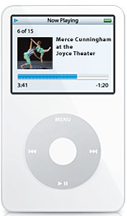
Merce + Rouse + iPod + Joyce
Last week, audience members enjoyed a unique experience in maverick choreographer Merce Cunningham’s newest piece, eyeSpace. Using iPod Shuffles, each member of the audience heard different pieces of composer Mikel Rouse’s score, International Cloud Atlas. The audience was provided with iPod shuffles, set to play the score’s tracks in a random order, giving each viewer a distinct viewing experience.
Audience members were requested to bring their own iPods, loaded with the score they downloaded from this page, to play during the performance of eyeSpace. For those who didn't have their own iPods, iPod Shuffles were available for use on loan (at no cost) at The Joyce Theater.
With your ticket purchase, audience members were also entitled to receive a free download of select tracks from Mikel Rouse’s score. [via Great Dance]
Posted by jo at 06:56 PM | Comments (0)
September 27, 2006
Jonah Bokaer
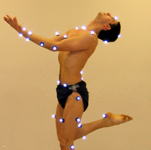
Dancing Up a Storm of Radical Doubt
Dancing Up a Storm of Radical Doubt by Jonah Bokaer: Flashing as dismissive an attitude toward status quo as Merce Cunningham—whose company he dances for—Brooklyn-based dancer Jonah Bokaer and the artists’ collective Chez Bushwick have recently initiated a nomadic experimental dance laboratory called AMBUSH. Each monthly installment of the program occupies a different loft space in Brooklyn’s Bushwick neighborhood. An outgrowth of Chez Bushwick’s remarkably successful SHTUDIO SHOW, AMBUSH is identified by the collective as “an ambulatory new program of dance, performance, and related forms.” NYFA Current asked Bokaer, Chez Bushwick’s manager and founder, to explain the evolution of the collective, their propensity for rigorous interviews of critics and curators, and how no reviews are allowed. [continue reading at NYFA]
Posted by jo at 07:13 PM | Comments (0)
September 14, 2006
ICH² - INTERMEDIA DANCE PERFORMANCE FOR PLANETARIUMS
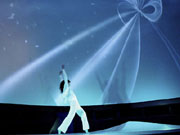
360 Degree Projection meets Motion-Tracking
ICH² - INTERMEDIA DANCE PERFORMANCE FOR PLANETARIUMS [Premiered on June 8, 2006 at the Mediadome in Kiel, Germany. The Programm will be resumed at the Mediadome in Kiel in February 2007.]
The performance ICH² combines dance and media art with complex content and attractive use of cross-media. Art and technology synergetically combine to a creative game on duplication and variation. ICH² is merging the components into a hybrid amalgamation, which creates a digital space of possibilities, which is not only reflecting the perspectives of genetechnology, but offers the visitor a new space for experience.
An intruiging atmosphere is created by the interaction between stage and the projection onto the dome. A unique installation for an extra-ordinary space: a planetarium including a 360 degrees moving image projection. State-of-the-art projection technology is merging with dance theatre and interactive media into a fascinating wholesome piece of art, is modifying it and allowing a completely new kind of production: dancer and media together create an artistic space that involves the audience in a new way. The impact of the imagery and the intensively short proximity of the performers, forms a high level of immersion.
Hardly has a visitor been closer to the dancers. This turns standard planetariums into experiental Digital Theatres, in which man and technology can be part of a unique symbiosys.
Tracking Bodies
The main area of research for project ReACT was the further development of the Tracking-technology in regard of the spacial and technical characteristics of planetariums. While usually only linear image sets were shown, the use of reactive software allowed interactivity and manipulation of the projected content.
Concept: With the help of installed cameras and sensors attached to the performer’s body, movements in the space can be tracked and transmitted to a computer system. A specially programmed software interprets the dancer’s movements in real-time, which in turn is then projected onto the dome as interactive projection and stage backdrop. This allows to create a digital double of the dancer: Motion Tracking as duplication process.
In this way a reactive visual and audio world is created, that synergetically re-interprets the image and audio composition.
Posted by jo at 06:32 PM | Comments (0)
September 08, 2006
DANCEPOD 2006

A Sculpture Composed of Simultaneous, Web-Connected Dance Parties
DANCEPOD 2006: On September 9th at 11pm in Portland, 12 am in Guadalajara, 2am in New York City, 3am in Mexico City and 7am in Berlin, dancepod will present an entirely new kind of sculpture. A sculpture composed of simultaneous, web-connected dance parties. The parties, coordinated and developed in conjunction with artists and presenters from each city, will utilize identical dancepod installations. The installations will become the core of a shared physical and virtual experience, supporting streaming video and music as well as live DJ’s, VJ’s, and surprising guest artists. Moving bodies of dancing participants will complete the sculpture.
As part of the Portland Institute of Contemporary Art's (PICA) Time-Based Art (TBA) Festival, in conjunction with PS122, Scene Downtown (Earl Dax), Harkness A/V (Nick Hallett), and technical directors Kraft + Purver, these 4 DANCEPOD sites will be linked by live video starting at 2:00 AM Eastern Standard Time.
NYC DANCEPOD features an eclectic array of New York artists. Join DJs Kevin Graves (Brite Bar) and Van Scott (Patricia Field's Party at element) and dance to visuals artists assembled by Nick Hallett and Harkness A/V, including Chika and Boris. Live performances by John Moran and Saori Tsukada, Sxip Shirey, and Glenn Marla.
Chez Bushwick will be hosting "The Changing of the Garde" starting at 8:00 PM on Saturday. Come early for DANCEPOD and enjoy performances by:
Wanjiru Kamuyu – Spiral
Jim Staley – Solo Trombone
Bruce Nauman - “Abstracting A Shoe (1966)” – Video Art
David Vaughan, Michael Cole, Jonah Bokaer – A John Cage Birthday Reading
Elke Rindfleisch - Untitled
Also... TECHNOPIA Interviews Carla Peterson, Newly-Appointed Artistic Director of DTW.
All this for $5. Come to both the Chez Bushwick and DANCEPOD events for just $10! That's like seeing the early show for FREE! (Regular DANCEPOD admission is $10).
Hosted By
3rd Ward Brooklyn
195 Morgan Ave.
Bushwick, Brooklyn, NY 11206
718.715.4961
www.3rdwardbrooklyn.org
Posted by jo at 05:46 PM | Comments (0)
August 17, 2006
"Echo" at the Tate Modern
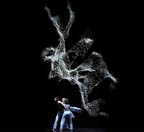
3D Point-Clouds in Real Time
UnitedVisualArtists have just uploaded on their website a video of their latest project, Echo. The 8-minute live performance piece was commissioned by Vamp and produced in collaboration with Mimbre for a launch in the Turbine Hall, Tate Modern in London. I found the video so beautiful that I pestered UVA with questions. Ash Nehru kindly answered me.
What's the technology behind Echo?
The LED screen we used was a Lighthouse R10 LED screen, 8m wide by 11m high. We used the Point Grey Labs' Bumblebee2 stereo camera system, mounted at the foot of the stage, and used our own proprietary software (dragonfly3) to render the resulting 3D point-cloud in real time. The motion of the 'virtual camera' was scripted within D3.
How about the collaboration with the dancers, Mimbre and choreographer Flick Ferdinando? How did it go?
Because we had very little rehearsal time (5 days), the dancers assembled the performance from sequences taken from their existing show, but simplified and slowed down to create a dreamlike, 'sculptural' effect. We set up the bumblebee system so that the choreographer could select moves that worked best for the camera.
Aside from offering our opinions as to which music worked best with which moves, we exercised as little control over the choreography as possible.
Once the choreography was fixed, we recorded the performance to create a 3D video file, which was then used to sequence the camera moves.
The idea for the performance came from our original work with the bumblebee system, an interactive installation called Mirror that we presented in the Kemistry gallery in horeditch, London. The particular rendering style we used for that project was developed slightly to work better with the LED screen.
Thanks Ash!
If you're in Northern Europe, Austin or Los Angeles, chances are that you can catch up with the work of UnitedVisualArtists, they are currently touring with Massive Attack.
More Interview of UnitedVisualArtists; their video for Colder. [blogged by Régine on we-make-money-not-art]
Posted by jo at 07:58 PM | Comments (0)
August 10, 2006
APPARITION II
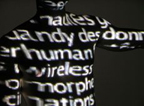
Furthering the Aesthetics of Body Projection
APPARITION II (World Premiere) Klaus Obermaier X Ars Electronica Futurelab :: 16-17.9.2006 (Sat-Sun) 8pm :: Auditorium, Kwai Tsing Theatre :: Details.
The camera based motion tracking system developed for APPARITION uses complex computer vision algorithms to extract the performer's moving outline or shape from the background to provide constantly updating information for a body projection as well as qualitative calculations of certain motion dynamics, e.g. speed, direction, intensity and volume. The information derived from these calculations is assigned dynamically to the real-time generation of visuals that are projected either directly back onto the body and/or as large-scale background projection. The precise synchronization of projections on the background and the bodies result in the materialization of an overall immersive kinetic space or a virtual architecture that can be simultaneously fluid and rigid, that can expand and contract, ripple, bend and distort in response to or an influence upon the movement of the performers.
Klaus Obermaier began with the production of D.A.V.E. (2000) (Digital Amplified Video Engine), a solo dance theater work, using a unique approach to moving body projections that fused body and image into a consistent narrative. Following the success of D.A.V.E. (having performed over eighty shows in eighteen countries), Obermaier embarked on the creation of another media and dance performance work, VIVISECTOR (2002). Neither of these works used interactive technologies, but relied on a creative and precise combination of set choreography, staging and recorded video.
Obermaier decided to further develop the aesthetics of body projection by making a piece that would use interactive technologies to release the performer from the determination of set choreography and would use digital media performance software to generate the video and sound content in real-time. Discussions with engineers and designers at the Ars Electronica Futurelab about building the interactive and real time generation system, and involvement in the organisation of the DAMPF_lab (Dance and Media Performance Fusions - a European joint performing arts / technologies research project) stimulated the initiation of the APPARITION (2004) and APPARITION II (2006).
Posted by jo at 08:45 AM | Comments (0)
July 28, 2006
Wald-Forest
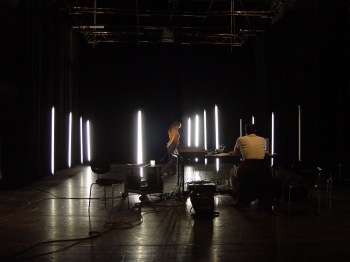
Responsive Architecture + Organism
Wald-Forest by Chris Ziegler :: a forest is both an architecture and also a organism. Forests are areas outside of civilization and human culture, ambivalent places of fears and inspiring fantasies. Wald-Forest is an interactive installation, a performance environment for dance, light, electronic sound and life piano. Neon lamps, hung in a matrix of 16 - 64 units, create a forest-like interactive matrix of light emmitting objects.
The installation is designed to be a light-architecture and also a responisve, digital organism. Moving in it can be as simple and playful as a shadowplay, but there is also disorientation in a matrix of light objects. The indeterminacy of places like this is most interesting to us. Wald-Forest's interactive light and surround sound architecture is related to the movement parameters of the dancer / the audience. The motion tracking parameters are: position and speed of movement.
Wald-Forest defines performative zones by light, shadow and sound. The performer / audience shapes and alters performative acoustic and light - zones by his own movement in realtime. In the live performance we will develop a duet for piano and dance. Real time notation instructions will be sent to the piano player according the dancer‘s movements patterns in space. Composed music parts will interact with algorithms of interactive sound.
concept, director: Chris Ziegler (D)
dance: Christine Bürkle (D)
music: Sandeep Bhagwati (D/IND)
prepared piano: Ernst Surberg (D)
Wald-Forest will be perfomed at Pas de Deux - Dance and New Media Performances, workshops, filmscreenings and interactive installation :: July 29-30 :: Edith Russ Site for Media Art :: Chris Ziegler will be on site for a talk.
The Edith Russ Site for Media Art, the Association for Youth Culture Engagement and the Kulturetage Oldenburg present a series of events which broach the issue of dance and new media. From 28 July until 6 August well known dancers, choreographers and dance companies as well as media artists will give a guest performance. The events will take place at the Edith Russ Site for Media Art and at the Kulturetage Oldenburg. Furthermore workshops will be offered in order to give an impression about dance and new media and to make first experience with "digital dance".
Posted by jo at 11:18 AM | Comments (0)
July 27, 2006
Cultural Control and Policy on Dance in Asia-Pacific Region
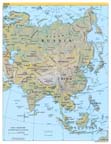
Call for Participation and Partners
[posted by Yukihiko YOSHIDA] Archive/Database: Publication and Material list for Cultural Control and Policy on Dance in Asia-Pacific Region :: Call for Participation and Partners :: Yaping Chen, PhD (Taiwan) :: Yukihiko YOSHIDA (Japan) :: The study in cultural control and policy would be an important field in dance research now, especially when we analyze the development of dance in Asia Pacific Region. Hence, a multi-lingual online archive serving as an exchange platform for research materials will greatly enhance cross-cultural research and understanding of this specific subject.
Now the first ever project in this regard is underway. As the first step, Yukihiko Yoshida and Dr. Yaping Chen are making publication and material lists for cultural policy related to dance under Japanese Colonialism before WW2. Even in Japan, this is still a hidden subject in both Japanese and Asian dance history researches. Yukihiko is currently compiling such a list within Japan. Related materials in difference languages are believed to exist in countries ranging from Japan, China, Taiwan and Korea to South-east Asian countries such as Malaysia. All the contributed lists will be credited with the contributors’ names and shared in the online archive.
Cultural policy under Japanese colonialism is just the beginning of the project, and compiling lists are but the first step. We hope to include publication and material lists from the more recent past in the archive as well. The ultimate goal of the project is to facilitate and promote researches in the relationship between cultural policy and dance throughout Asia-Pacific Region. In the future, cross-national research projects may be conducted through the international connections made possible by this online archive.
We look forward to welcoming new members and partners.
contact address: Yukihiko YOSHIDA, yukihiko9[at]s6.dion.ne.jp
Posted by jo at 02:45 PM | Comments (0)
July 24, 2006
Tap-n-bass
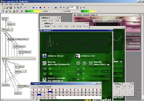
Interactive Dance Technology
Within the field of interactive dance technology, a number of projects have experimented with dancers producing music in real time from their body movements, as opposed to following the music. In MusicViaMotion (2000) for example, dance movements are captured with a video camera and mapped to sound synthesis in real time. In MIT Medialab's Expressive Footwear project (1998) and Katherine Moriwaki's Music Shoes (2000), the dancers wear sport shoes respectively chinese slippers, equipped with a range of sensors. In Alfred Desio's Zapped Taps, sensors are also used, this time on tap shoes. In all these projects, the sensed movements actuate and modulate artificial sounds.
In Tap-n-bass, we took a technological step back and used the actual acoustic sounds produced by the tap shoes instead of sensor data about the dancer's movements. Tap-n-bass is an improvised tap dance performance where the sounds of wired-up tap shoes are picked-up by piezo contact microphones and remixed live, resulting in drum-n-bass-inspired music.
Drum-n-bass is one of the most exhilarating music styles that have emerge during the last few years. Noticing pattern similarities between certain rhythms in drum-n-bass and in tap dancing, we decided to see what would happen if we crossed these two genres. In Tap-n-bass, we aimed at making a tap dance performance that would produce booming bass and fast syncopated rhythms reminiscent of drum-n-bass, while staying true to the genre of tradition of tap dancing and its characteristic sound. The music is produced live by sounds picked-up by contact microphones attached on the shoes. The sounds are filtered and remixed live through a mixer board and custom-made program run on a laptop. The Tap-n-bass performance is improvised and collaborative, in terms of the dialogue established between the laptop remixer and the tap dancers. [via nicolas on pasta and vinegar]
Posted by jo at 06:59 PM | Comments (0)
July 12, 2006
SEA UNSEA
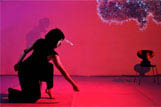
dans-architecture
Sea Unsea takes place on an interactive stage informed by a camera interface. On an empty floor and beneath a slanted cloud canopy, four performers begin by simply walking. As they cross the floor, their movements affect a sonorous field of sound while tides of virtual sea meadows are projected onto the canopy above. Capturing the fleeting forms of this virtual sea, the performers play and explore, attracting, repulsing and entwining their bodies and voices within the evolving patterns of a swirling hynotic synthetic sea. Testing the physical and emotional thresholds that separate them from the rootless sea meadow the work develops through repetitive tides of action. Across time the sea gradually evolves as a growing ecology embedding the presence of the performers as mnemonic traces within a dense field.
Sea Unsea is an interactive dans-architecture conceived by between architect Mette Ramsgard Thomsen and choreographer Carol Brown and developed in collaboration with Chiron Mottram and Alan Penn from the Virtual Reality Centre for the Built Environment, Bartlett School of Architecture, University College London.
Sea Unsea builds on Carol Brown and Mette Ramsgard Thomsen's former collaborations, The Changing Room and Spawn.
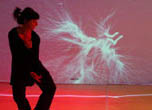
Research Questions: Sea Unsea explores new intersections between embodied interface design and an intelligent digital environment. By adapting the Virtual Reality Centre's crowd visualisation software, we are investigating the making of a digital ecology of virtual agents acting and reacting on the presence of the performer. The agents can be understood as a swarm of digital beings that interact with each other as well as react to changes in their environment. Defined by low-level rules that lead to the emergence of a high-level patterning, the agents inhabit the two dimensional surface of the camera picture plane. As they seek to navigate the plane, drawn by defined points of attraction, and hindered by shades of darkness, they encounter the performers, negotiating their presence, confronting, traversing, intersecting or evading their image.
Posted by jo at 07:09 PM | Comments (0)
July 10, 2006
Chasing Pools and Sampling Ghats

HIDRAZONE ISSUE 002 X 2
Chasing the Pools is an immersive performance/installation working with integra-ting the live presence of dancers into the landscape of a multi-channel live-mix video installation. Often the two present very different viewing circumstances that remain independent of one another.
Through live-feed cameras the movement of dancers was mixed into the alpha channel of 3 video mixes. Their lit bodies became one moving image, dematerializing or re-materializing the body, while the background remained another. The dancers were able to monitor how they were affecting the composited image, essentially dancing with the image.
These channels were projected onto numerous scrims in a large tree grove. Twelve channels of sound by live musicians were mixed and spatialized throughout the site. The architecture of a tree grove naturally imposed a de-centralized structure upon the viewer where one’s experience was shaped by the act of meandering through, never being allowed a view of the whole.

Samples of the Ghats is a responsive installation that invites the audience to explore the ghats of Haridwar, India by composing themselves its audio-visual atmosphere.
A 5 metre long structure featuring a panorama of the ancient and holy city of Haridwar framed with technology is a stimulus to curiosity, an appeal to exploration. Cruising along the panel visitors soon discover that they can "play it." With the simple move of his hands he launches media sequences. They are audio and visual samples, pieces of Haridwar, collected and edited in a way to generate an atmospheric feel of the ghats.
In a collective experience, the panorama comes to life and the adventure begins.
More Hidrazone Issue 002: Performativity
Posted by jo at 07:26 PM | Comments (0)
June 24, 2006
Nathaniel Stern: Creative Commons Artist in Residence
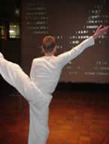
Shares [odys]elicit Under CC/GPL
Friday 23 June 2006, live from the iCommons iSummit:
[odys] elicit - a full-body, interactive art installation circa 2001 - is now available under a Creative Commons By Attribution Non-Commercial Share-Alike license, and the source code is available under GPL. It works with almost any standard webcam (requiring a few drivers on PC)!
[odys]elicit is a large scale, interactive installation where every movement of the viewer, small or sweeping, births stuttering text onscreen. The viewer’s motion elicits, character by character, passages from odys’ text. The piece responds to small movements, writing the text onscreen slowly for the viewer to read, or to rapid passersby, whose full bodies birth hundreds of flying characters, impossible to decode.
In odys’ work, viewers are forced to look at the spaces between language and meaning, the luxuries of stuttering and silence as communication, and the effects of accelerated and decelerated time. [odys]elicit physically places viewers at the center of co-invented noise, forced to perform - willingly or not. odys’ text has been reduced down to where it no longer has meaning and is re-birthed, with possibly infinite meanings, or none at all.
Click here to see videos of the piece in action.
Downloading:
Please first check out the read_me file - the PC application requires some extra (free) installs, and you can very easily change video settings or sources, input new text, toggle between birthing letters or full words, adjust the motion tracking tolerance levels given different lighting, or change the direction the text will go on the fly! Send me error messages if you encounter any bugs, or have much success! I am yet to fully test the OS 9 or PC versions. Oh, and about any parties or exhibitions that this thing is a hit at, too ;)
read_me.rtf
OS X Application
OS 9 Application
PC Application (still testing)
Source Code (in Director/Lingo + TTC-Pro; demo versions of these will work)
@ Rio iSummit [posted by nathaniel on nathanielstern.com]
Posted by jo at 10:38 AM | Comments (0)
May 30, 2006
Johannes Birringer
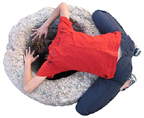
DANCE AND NEW MEDIA TECHNOLOGIES
Johannes Birringer will direct an international workshop on DANCE AND NEW MEDIA TECHNOLOGIES in Istanbul, Turkey, April 3 - 7, 16:00 - 21:00, each day at Çaty Dance Studio; There will be a final workshop demonstration / performance, Friday, April 7, 20:30. The Seminar: "Media Technologies" will be held on April 6, 11;00 - 13:00, Bilgi University, Dolapdere Kampüsü, Çizgi Atölje. This workshop is part of a larger series of events planned this year in Istanbul, involving practical laboratories, performances, and seminars with local artists and guest artists from the dance world and the dance and technology community.
Workshop and events organisation by: Vivian Saragosi, Dijan Albayrak, Ayse Orhon, Mekan Contemporary Dance Studio & (new) Contemporary Dance and Certificate Program (Bilgi University) in cooperation with Aylin Kalem, TECHNE Festival.
Posted by jo at 09:49 AM | Comments (0)
May 17, 2006
Performance Paradigm, Number 2

Japan After the 1960s: The Ends of the Avant-Garde
"It is widely acknowledged that dramatic changes wrought in 1960s Japan were such that art and cultural practice were transformed into an emergent avant-gardism. Hybridity, physical and intellectual intensity, formal innovations and transgressive acts are all characteristics of 1960s theatre, dance, cinema, literature and performance art in Japan and elsewhere.
The 1960s era was significant not least for the emergence of new aesthetics connected to a rapid evolution of political sensibilities. In Japan, as in Europe and America, artists were rethinking materials and forms often in terms of bodies juxtaposed with mediated spaces and objects. Art works began rejecting academic and formal qualities of art and instead related to the everyday experience of the world, foregrounding experiences of time and immediate sensory perception in a language which was conceptual and dynamic. This emerging performative discourse challenged ideas of representation and politics in art as performance began re-connecting with the social sphere.
As Marvin Carlson suggests, it is a language and a set of practices which became paradigmatic of the post 60s world: 'With performance as a kind of critical wedge, the metaphor of theatricality has moved out of the arts into almost every aspect of modern attempts to understand our condition' (Carlson, 1996: 6). This issue of Performance Paradigm looks at some of the places this metaphor migrated to and investigates how, in the process, ideas of culture and experiences of the world became actively performative. In a similar vein, this issue examines how perception and experience in the arts in the post 60s era came to stand for the embodiment of a new politics..."
ARTICLES
- Peter Eckersall and Edward Scheer 'Introduction'
- Satô Makoto, translated by Yuji Sone 'On Vernacular Theatre'
- Yasuko Ikeuchi 'Performances of Masculinity in Angura Theatre: Suzuki Tadashi on the Actress and Satô Makoto's Abe Sada's Dogs'
- Michael Hornblow 'Bursting Bodies of Thought: Artaud and Hijikata'
- Shannon C. Moore 'Ghosts of Premodernity: Butoh and the Avant-Garde'
- Jonathan Marshall 'Dancing the Elemental Body: Butoh and Body Weather: Interviews with Tanaka Min and Yumi Umiumare'
- Lisa Kuly 'Translation, Hybridity, and 'The Real Thing': Don Kenny's English Kyôgen'
- Vera Mackie 'The Spectacle of Woman in Japanese Underground Theatre Posters'
- Midori Yoshimoto 'Off Museum! Performance Art That Turned the Street into 'Theatre,' Circa 1964 Tokyo'
- Gunhild Borggreen 'Ruins of the Future: Yanobe Kenji Revisits Expo '70'
- Uchino, Tadashi 'Mapping/Zapping 'J' Theatre At The Moment'
BOOK REVIEWS
M.Cody Poulton, 'Unspeakable Acts: The Avant-Garde Theatre of Terayama Shûji and Postwar Japan' Carol Fisher Sorgenfrei
Mika Eglinton, 'Into Performance: Japanese Women Artists in New York' Midori Yoshimoto (New Jersey and London: Rutgers University Press, 2005).
Yuji Sone, 'Alternatives: Debating Theatre Culture in the Age of Con-Fusion,' Peter Eckersall, Uchino Tadashi and Moriyama Naoto (eds.), No. 11 in the series Dramaturgies: Texts, Cultures and Performances (Brussels: P.I.E.-Peter Lang 2004).
EVENT REVIEW
Zack Fuller, Tradition and Innovation: Dance Hakushu 2005. August twelfth through twenty-first, Body Weather Farm, Yamanashi, Japan.
From Japan After the 1960s: The Ends of the Avant-Garde, Performance Paradigm, Number 2, Edited by Peter Eckersall, March 2006 [ISSN 1832-5580]
Posted by jo at 10:02 AM | Comments (0)
@ Beyond Dance Film: Physical Expression
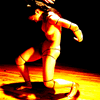
Wear + Tear
@ Beyond Dance Film: Physical Expression and Visual Media, Hammer Museum Courtyard, Saturday, June 10, 8 - 11pm. Beyond Dance Film is a unique installation of 25 international short dance films that explores the body and movement as a means of expression through all kinds of electronic visual experiments projected continuously on multiple screens and surfaces throughout the Hammer Museum Courtyard.
Wear + Tear; Interactive Performance; USA 2005/18 min; Director: Eric Koziol; Choreographer: Mei Yin Ng--Inspired by the quest for perfection, the degradation of a dancer’s body over time, medical imaging, and robots, Wear + Tear presents the dancer as a newly created robot. A series of repetitive physical tasks akin to a self-diagnostic are augmented by the sounds of mechanistic limbs and joints as body-mounted surveillance cameras permit the audience to adopt the perspective of the robot-dancer’s wrist and knee.
As the robot-dancer malfunctions, another series of tests uses rays of light to mimic an internal diagnostic as video projected directly onto the body reveal its inner workings. Making visible the normally invisible aspect of dance, these interior views of the body are synthesized from animated sources that include machine part, graphic depictions of the Chakras, Japanese anime, time-lapse photography, and “cellular animation.
As the robot-dancer begins to sputter, spin, and fall, the viewer’s perspective shifts to beneath the floor. Nearly exhausted, it drags itself across the floor as an awareness of its own deficiency conjures up a mental image of a body trapped inside a bubble. The restricted movement mirrors the body’s own limitations, revealing that perfection is impossible to achieve and that, from its inception, this bio-machine is destined to break down.
Wear + Tear was co-produced by the LEAP Festival 2005 Liverpool, UK
Eric Koziol: A founding member of the media collective H-Gun Labs, director Eric Koziol has collaborated with musical artists such as Nine Inch Nails, Public Enemy, Sound garden, De La Soul, Diamanda Galas, as well as television personalities Howard Stern, Roseanne Barr, and Michael Moore. His film and video work encompasses both experimental single screen works and multi-screen interactive video environments for theater, music and dance. His films have screened in the Dance on Camera Festival in New York, American Dance Festival, Cinema Museum Moscow, Fillmore Far East in Tokyo, and TTV Festival in Riccione, Italy. His live multi-media works have been showcased at PS 122 in NYC, Ontological Theater NYC, The Leap Festival in Liverpool, Rotterdam International Film Festival, and Boston’s Cyberarts Festival.
Mei Yin Ng: Chorographer and dancer Mei Yin Ng has collaborated with Remote Control Productions/ Michelle Laub in Europe, Nyo-Ba & Dancers in Malaysia, AMEYE in New York City, and choreographers such as Sally Gross, Bryan Hayes, Manuel Alum, Karl Hoass/ Damage Control & Maureen Fleming. The founder of the interactive artists collective Mei-Bee Whatever Company, her work has been presented at Dance Theater Workshop, La Mama Etc., PS122, Movement Research, The Construction Company, Italy’s Fabbrica Europa, and the International Choreographer’s Platform in Almada Portugal. Her work with Mei-Bee whatever has been funded by the Manhattan Community Arts Fund & a New York Foundation for the Arts Fellowship.
See culturebot.org interview >>
Posted by jo at 08:37 AM | Comments (0)
May 05, 2006
MIT List Visual Arts Center

Art + Technology
Currently at the MIT List Visual Arts Center, Cambridge, Massachusetts: 9 Evenings Reconsidered: Art, Theatre, and Engineering, 1966; Choreographic Turn: Daria Martin; Peter Welz in collaboration with William Forsythe; and Chris Doyle: Recent Video Works
9 Evenings Reconsidered: Art, Theatre, and Engineering, 1966, Curator: Catherine Morris.
This exhibition, organized by independent curator Catherine Morris, takes a fresh look at 9 evenings: theatre and engineering, a series of performance events organized by Billy Klüver, a Bell Laboratories engineer, that took place at the 69th Regiment Armory in New York from October 13-23, 1966. 9 evenings featured ten artist/engineer collaborators who attempted to realize previously unattainable creative projects. 9 Evenings was a significant turning point for many artists who became aware, many for the first time, of the implications that advancements in technology had for the development of their own work. The exhibition 9 Evenings Reconsidered: Art, Theatre, and Engineering, 1966 includes works of art, ephemera, drawings, film, and photo documentation of the 1966 performances.
The artists involved in 9 evenings: theatre and engineering were John Cage (composer); Lucinda Childs (dancer and choreographer); Öyvind Fahlström (painter and author of theater pieces); Alex Hay (painter and choreographer); Deborah Hay (dancer and choreographer); Steve Paxton (dancer and choreographer); Yvonne Rainer (filmmaker, dancer and choreographer); Robert Rauschenberg (painter and choreographer); David Tudor (musician and composer); and Robert Whitman (film/video artist, author of theater pieces). Bell Laboratories’ Billy Klüver brought these artists together and paired each artist with an/a Bell Labs engineer to create new works. Engineers included: Per Biorn, Cecil Coker, Ralph Flynn, Larry Heilos, Peter Hirsch, Harold Hodges, Robert Keronski, Jim McGee, Robby Robinson, Herb Schneider (MIT Class of 1948), Fred Waldhauer, Witt Wittnebert, and Dick Wolff.
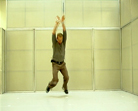
Choreographic Turn: Daria Martin; Peter Welz in collaboration with William Forsythe, Curator: Bill Arning, MIT List Visual Arts Center.
This exhibition features a 16mm film entitled Soft Materials by Daria Martin, an American artist living and working in London, and a large five-screen video installation entitled whenever on on on nohow on / airdrawing by German artist Peter Welz in collaboration with celebrated dancer/choreographer William Forsythe. In bringing together the work of these artists, curator Bill Arning offers audiences the opportunity to consider the space between dance and moving image in contemporary art practice. There is a growing history and cultural practice of choreocinema, or dance on film/video, a hybrid art form that offers previously unavailable experiences of dance. Choreographic Turn celebrates this exciting shift in cultural practice by showing two recent extraordinary iterations of this new form-film/video installations offering new modes of experiencing the art of bodies in motion.
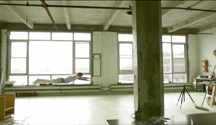
Chris Doyle: Recent Video Works
Flight (2005) 31 seconds
Tower (2005) 4 minutes
Hotel Bernini I (excerpt) (2004) 2 minutes, 33 seconds
Watershed (2004) 3 minutes, 02 seconds
Extraordinary Perceptual Dilemmas and the Madness of Climbing (2003) 1 minute, 30 seconds
Chris Doyle's themes are drawn from the psychology of everyday life. By using only the most low-tech special effects, he transforms everyday images into short films that are magical and moving.
Doyle is perhaps best known for Leap , a public artwork sponsored by Creative Time in April, 2000, for New York City's 2 Columbus Circle. A celebration of hope, Leap , showed moving images projected onto a tall building of various New Yorkers from all five boroughs jumping skyward. Beginning at dusk, depictions of a continuous stream of New Yorkers appeared at the base of the building, and one by one, four hundred and twenty jumpers soared up the height of the facade, slipping into the night sky.
In recent years, Doyle has worked less in the public sphere, and more in the private fictional spaces he creates in his videos. This selection of videos shows a wide range of Doyle's interests, but each manifests a dreamlike vision in which the quotidian becomes extraordinary. Doyle likens his practice to a "Pathetic Magician, a sad sack trying to make magic out of what is at hand."1 Writing in Art News magazine Linda Yablonsky said "(Doyle) has cast hot dogs, red bricks, and lawn chairs as human surrogates in videos that constantly mix storytelling with abstraction." 2
Flight (2005) shows the artist doing aerial circuits in a Superman pose around his Brooklyn studio before heading out the window. Today, when even amateurs have access to Hollywood-quality special effects, the artist's goal is clearly not a seamless effect. The jerky motion is left as a clue to his methodology, in which the artist performed 230 individual leaps and then sequenced the still photographs to depict flight.
Tower (2005) uses an animation technique known as "claymation". Doyle has turned the descriptive form upside down; and we see the effects of unseen artist's hands on the tower, wounding and suturing the form. and twisting it like taffy.
Hotel Bernini I (2004) is among Doyle's most evocative works, in that how one perceives the turbulence of the white hotel sheets will invariably be affected by one's own psychology. Whether it is understood as the result of anxiety, insomnia, or passion, the sheets are now vacant, and the bodies that gave them life are now missing.
Watershed (2004) shows a partly deconstructed bank building that the artist found in upstate New York. Using only flashlights for special effects, Doyle uses the skeletal frame as a metaphor for the psychological structures that contain thought, with the flashes of light serving as the events or perceptions that define human relationships. The artist appears at the very end sweeping up after the emotional fireworks.
Extraordinary Perceptual Dilemmas and the Madness of Climbing (2003) was a site specific project done for an exhibition in East Hampton, Long Island, NY. Like many natural paradises that have become popular resorts, longtime residents describe the area's past in idyllic terms that are too dreamy to be true. The old movie feel and the slightly horrific over-profusion of images are meant to conjure the dark side of paradise.
Posted by jo at 10:51 AM | Comments (0)
April 28, 2006
Cinedans

Workshop Interactive Dance Film @ Mediamatic
Workshop Interactive Dance Film - Cinedans 2006; June 25-29 @ Mediamatic; 1 July presentation of results.
THE WORKSHOP: Together with the Cinedans Festival, Mediamatic organizes a workshop on interactive dance film. In this workshop, 16 international dance filmers, editors and choreographers make interactive online dance films or dance film installations, using their own footage.
Interactive film offers interesting new forms of contact between the film and its viewer, but also requires other ways of shooting and editing the material. The participants research the relations between the paths of the camera, the movements of filmed bodies, the dramaturgy of the viewer and its movements on the screen or through space (in case of an installation), that together make up the form of the interactive dance film.
TRAJECTORY: The workshop is an intense 5-day process. Starting off with a close study of several intriguing interactive dance film projects on the first day, the participants create the content, form and interactive experience of their project, discuss it with experienced trainers and participants, and build a working prototype assisted by technical assistants.
Participants can bring up to 40 minutes of material, on dvd, or on FireWire harddisk, preferrably in Quicktime movie format. Participants use an easy-to-learn tool, that allows the projects to be published online, or on dvd-rom. All participants are assisted personally in realising their workshop projects. Specific technical knowledge of new media is not required.
HOW MUCH AND MORE INFO
The workshop fee is €300 (incl. VAT) for participants from new member states of the EU and €420 (incl. VAT) for participants from other EU member states.
Registration is possible online. Mail any questions you might have to workshops[at]mediamatic.nl or call Klaas Kuitenbrouwer: +31 20 6389901.
This workshop is made possible with the support of the MEDIA PLUS PROGRAMME of the European Community
Posted by jo at 12:18 PM | Comments (0)
April 18, 2006
Ken Goldberg's Ballet Mori

A Ballet Conducted by the Earth
To commemorate the 1906 San Francisco Earthquake, Ken Goldberg conceived Ballet Mori to engage the Earth as a living medium and a conductor for dance. For the first time, network technology was combined with ballet to directly link the natural world to classical performance.
In this improvisational performance, SF Ballet Principal Dancer Muriel Maffre responded to a musical composition modulated live by the unpredictable fluctuations of the Earth's movement as measured in real time by a UC Berkeley seismometer at the Hayward Fault. [Wired article]
"April 18 is the 100-year anniversary of San Francisco's Great Earthquake. How can we understand sounds far too sublime to be perceived by the human ear?
This question was brought to the fore by a team of American media artists led by UC Berkeley's Ken Goldberg in "Ballet Mori," performed at the San Francisco Opera House April 4 to commemorate the 1906 Earthquake. Muriel Maffre, a principal dancer of the SF Ballet, danced to sound activated directly by the movements of the earth. Seismic data from the Hayward fault was transmitted to the opera house via the Internet and transformed into a soundscape by composer Randall Packer using Max/MSP. All in real time. The performance brought to mind Walter Benjamin's concept of the "optical unconscious." Just as the technology of photography makes it possible to see things normally invisible to the naked eye, Ballet Mori's networked sound system facilitates a meditation on the "acoustic unconscious." It allows the audience to hear the sound of the earth, which cannot be heard with the naked ear. The result was a suggestive and very beautiful synaesthetic experience that challenged the classical ballet audience and ordinary patterns of hearing. Video clips are online at: http://goldberg.berkeley.edu/art/Ballet-Mori/"--Ballet Mori and the Acoustic Unconscious by Anna Orrghen.
Anna Orrghen is a PhD Candidate in Media and Communication Studies at Stockholm University. She is currently finishing her dissertation, which explores the process by which a new medium emerges, with special attention to the discourses of art and Swedish mass media at the turn of the 21st century. She also works as a cultural critic in Sweden. e-mail: anna.orrghen[at]sh.se
Posted by jo at 05:26 PM | Comments (0)
2006 Dance Research Society, Taiwan [DRST] ANNUAL CONFERENCE

Dancing under the Rising Sun: Call for Papers
[Submitted by Yukihiko YOSHIDA] 2006 Dance Research Society, Taiwan [DRST] ANNUAL CONFERENCE: Dancing under the Rising Sun: The Influences of Japanese Colonialism on Dance in the Asia-Pacific Region; 8 - 10 December 2006, Taipei National University of the Arts.
What did the Japanese colonialism bring to the colonized countries in the Asia-Pacific region before the end of the Second World War? Political hegemony or modernization? Uprooted traditions or transplanted new cultures? How has this legacy of colonialism molded the dance scene in contemporary situations in various Asian countries?
As a result of the search for national identity in the postcolonial era, Taiwan's reflections on the Japanese colonial influences have continuously motivated the academic to examine the ideological and practical impacts that have intertwined with or even dominated peoples' daily lives in many aspects and on different levels. In the area of dance in particular, Japan once served as the channel for the 'new dance' formulated in Europe and America; moreover, the Japanese regime nurtured the first generation of contemporary choreographers and dance educators in Taiwan. In recent years, studies focused on this period have begun to accumulate and gained attention among the academics and dance practitioners alike.
Though many Asia-Pacific countries shared the common past of Japanese occupation before 1945, their colonial experiences were hardly a unified one. Different cultural schemes and historical courses contributed to the complexity of regional developments. This conference is the first attempt to gather, compare, exchange, and reflect on the experiences of different countries and geographic areas. Diverse and even contrasting interpretations of the influences of Japanese colonialism are expected, and will surely broaden our understanding of how human beings connect themselves to history, culture and society through dance. Dance practitioners, scholars and historians, as well as researchers in culture studies and other related social sciences, are welcome to participate in and contribute to this dialogue. The conference's themes include:
1. Colonial modernity: influences of Japanese colonialism on various dance practices and their relations to the social process blending colonization and modernization.
2. Cultural hegemony and aesthetics: the influence of Japanese hegemonic ideology on aesthetic conception which modified or formulated new genres, styles and categories of dance.
3. Gender, class and national identity: the strategic production of dances as the reflections of the newly-formed social stratification under colonialism
4. Other related topics.
The official languages of the conference are Chinese and English. Proposals
of the following forms are welcome:
1. research papers
2. theme panels
3. video/image presentations
Those who are interested in presenting should submit an abstract no more than 500 words in Chinese or English before 1 April 2006. The abstracts will be reviewed anonymously by the conference committee, and the result will be announced by 15 May 2006. Please fill in the attached form of submission, and send it along with the abstract by E-mail to Ya-ping Chen, PhD at ypchen@[at]nce.tnua.edu.tw. An e-mail receipt will be sent to the applicant as the confirmation of submission.
Conference Committee:
Dance Research Society, Taiwan (DRST)
Graduate School of Dance Theory, Taipei National University of the Arts # 1,
Hsueh-yuan Rd., Peitou, Taipei 112, TAIWAN
Submission Form
Family Name: First Name:
Nationality:
Affiliation/Institution and Position:
Contact e-mail address:
Contact phone number:
Contact postal address:
Title of paper/theme panel/video or image production
Equipment needed:
Posted by jo at 11:43 AM | Comments (0)
March 14, 2006
Networked Choreography - ii
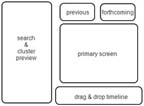
Web 2.0 and Hyperchoreography's Conceptual Promise
"In a networked environment where all links are revealed and 'new' links can added by users, multi directional - two way connection enhance the perception of intertexts. No longer must the author use chance procedures to disrupt their unconscious constructions of meaning, the provision of a mechanism to explore, expand and visualise the intertexts of their authored text performs the same function.
But we can go further ... I suggest we can best preserve the Dasein of 'filmed' motion by presenting it 'as is' - multiple representations reveal no more than a detailed examination of a single artefact. The intertwingularity of content on sites such as flickr is enhanced by user annotation, tagging and clustering. The audience is left navigate the interpretive space from their own perspective whilst divergent contexts are offered for further exploration.
By leveraging the developments of Web2.0 hyperchoreography can achieve it's conceptual promise. Users would upload video files of dance to a central server and annotate the files with relevant meta data and tags. each video would be converted into a common format and time code segmented to allow multiple points of entry." From networked choreography - ii on Splines in Space.
Posted by jo at 05:22 PM | Comments (0)
March 08, 2006
Internet2
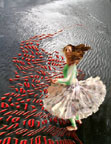
Expanded Opportunities for Arts and Performance
"I spoke with Ann Doyle this morning. Ann is the manager for Arts and Humanities Initiatives at Internet2, a consortium of universities, industries and government that are developing and deploying advanced networking applications and technologies. (Beth Miklavcic and Jimmy Miklavcic, whom I interviewed yesterday about their InterPlay performance, use the Internet2 for their distributed programs).
You should definitely visit the link to the Arts and Humanities Initiatives that I just mentioned above. There are some fascinating resources about a range of distributed arts programs. I happened to come across an interview (PDF) with James Oliverio, director of the Digital Worlds Institute at the University of Florida, whom I'll be interviewing tomorrow about their dance and performance programs that unite multiple locations around the globe.
I first contacted Ann Doyle because I wanted to learn more about the "Cultivating Communities" dance program that she hosted for Internet2 in 2002. If you visit "Cultivating Communities," you can learn about a series of dance performances that brought together dancers from multiple locations using motion tracking, motion capture and other interactive technologies in conjunction with the near TV broadcast quality of the Internet2 infrastructure - you'll also find a number of videos for these performances.
Ann believes that there are two important ways that the Internet2 project contributes to fostering new types of artistic possibilities and performance opportunities.
First, the network infrastructure delivers near broadcast quality video and audio to participating sites. Plus, there is very low latency, which means that the "roundtrip interactive time," as Ann says, is virtually nil. With top-notch video and low-latency, there are opportunities for distributed spontaneity that really didn't exist before when collaborating with remote colleagues and artists.
Second, this network infrastructure provides an opportunity for dancers and other artists to "think digitally." For example, if you go back to the "Cultivating Communities," a new choreographic question arises. Choreographers now have to think beyond the fixed borders of a single stage and consider their work in the broader context of multiple locations joined together by a digital network. These types of distributed programs raise many questions about the choreographic process and dance in general.
They also raise the question of how dancers and other artists are being prepared for distributed programs at the college and university level. Ann mentioned the Manhattan School of Music (MSM), which has been a leader in leveraging the Internet2 for conducting master classes and performances. Here's an article by Christianne Orto about the educational programs at MSM. Orto is the director, recording and distance learning at MSM and you can read an overview of their Distance Learning programs. Ann also directed me to dance programs at universities that are using Internet2 to conduct performances and classes - I'll be following-up soon with these contacts." [blogged by Doug Fox on Great Dance Weblog] [Related post: Interview with Another Language About InterPlay (image above)]
Posted by jo at 02:33 PM | Comments (0)
March 03, 2006
Yacov Sharir Interview
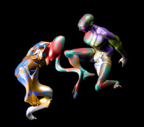
Wearable Computers and Performance
Today I interviewed dance and technology pioneer Yacov Sharir about his research in wearable computers and performance. In this post you'll find a profile of Yacov Sharir, pictures from his research, and external links to related articles and performances. Click here to listen to audio interview (MP3 format - Stereo - 8.85 MB - 19:20 Minutes)
Yacov Sharir is a choreographer, dancer, technologist and innovator. He is a professor of Theatre/Dance and Virtual Environments at the University of Texas-Austin and artistic director of the Austin-based Sharir Dance Company. He has performed under the direction of Martha Graham, Jerome Robbins, Jose Limon and Anna Sokolow. Sharir is the founder of the American Deaf Dance Company and the Sharir Dance Company. As a multiple recipient of the National Endowment for the Arts Choreographic Fellowship, he has choreographed for the Bat-Sheva Dance Company, Hartford Ballet, Dallas Ballet, the Kibbutz Dance Company of Israel, the Utah Repertory Dance Theatre and others. He was a recipient of an "Arts And Virtual Environments" two-year fellowship awarded by the Banff Center for the Arts and is engaged in extensive international lectures and workshops directly related to the issues of virtual environments, cyberspace and computerized choreography.
Links - Articles, Papers and Research:
- Yacov Sharir - Associate Professor of Theatre and Dance at the University of Texas-Austin
- Explorations in wearable computers
- Cyber Human Characters and 3D Worlds
- cyberPRINT project and performance
[blogged by Doug Fox on Great Dance Weblog]
Posted by jo at 11:32 AM | Comments (0)
March 02, 2006
Devolution

Realizing Extreme Parameters for Choreographic Invention
Internationally acclaimed choreographer Garry Stewart and Australian Dance Theatre break new ground in their collaboration with renowned Canadian robotics artist Louis-Philippe Demers to create a singularly unique world the likes of which Australian theatre has never produced before - Devolution.
Situating dancers in communion with numerous large and medium scale robots, a kinetic set, robotic protheses and ‘body parts’, Devolution explores the anthropomorphic potential of robotic machines and the nature of human consciousness. Filled with symbolism and ritualised process Devolution highlights that for all of our technology we are still primitive, of the flesh and live as instinctive biological beings.
As performing entities, the robots are given equal status to the human bodies in the work, albeit with some major operational differences. I haven’t tried to conceptually separate robots and humans as different ‘species’ but have been interested in the collision and confluence of the two. Let’s see what happens when we collide these operating systems—that sort of thing. It’s as much an experiment in morphology and function as anything else, explains Australian Dance Theatre's artistic director, Garry Stewart. [via Regine on we-make-money-not-art]
Posted by jo at 08:26 AM | Comments (0)
February 15, 2006
Videodances by Mimi Garrard

CREATING DANCE FOR VIDEO Streamed Online
A new short documentary, FORGING A NEW CAREER / CREATING DANCE FOR VIDEO, is featured on Mimi Garrard's web site this month.
The 42th half hour program of Videodances by Mimi Garrard will be shown in Manhattan Thursday February 23 at 9. p.m. and Sunday February 26 at 3 p.m. on Channel 56. The shows will be streamed live on the web and are accessible to people without cable or outside of Manhattan. Go to http://www.mnn.org/ and click on Channel 56 during the time and date of the program.
During the month of February Mimi Garrard has a dance installation at the Varga Gallery in Woodstock, New York.
Posted by jo at 07:34 AM | Comments (0)
February 14, 2006
Ying Zhou's
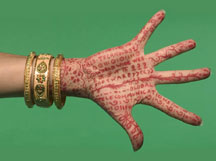
Dance Diary
Ying Zhou's Dance Diary utilizes blogging as a tool for soliciting feedback about her dances, especially from people who are far away. "Some of the diary entries are developed into theater work based on the viewer's input. I am living in Seattle and people from China and other countries in Asia are visiting my dance diary. I truly think this kind of reach and interaction with viewers is unique to internet. Living Seattle, I was highly influenced by the local dancer audience, predominantly white and middle class. It is quite limiting. My first work coming out of the dance diary was developed mostly under encouragement by comments from China. Among the entries, a lot of people said they liked the particular one. So I went ahead to develop it into a fuller solo. It now has been shown around Seattle theaters.
I spend a lot of time surfing the dance blogs and online dances. I have to agree with one of the postings on your site that very few of the dances online are created for the internet. I think my project is one of the few that are meant for the internet, meant to explore how technology changes my way of interacting with the viewers through my art."
Posted by jo at 11:01 AM | Comments (0)
February 13, 2006
man in|e|space.mov
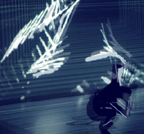
Three Views/Visions of the Body
"ABSTRACT: The article documents the theoretical and aesthetical basis of the interactive dance performance man in |e|space.mov. The text discusses the abstraction of the human body in this performance by an interactive costume of light whose motion is analyzed by a 3D motion-rendering programme, which assembles and recombines the captured frame in real time in electronic 3D space. Thus appears a juxtaposition of 3 visions on the body making up the representation: the eye of the spectator, the camera and the 3D camera view: 3 visions constituting the contemporary body. Furthermore, the text questions the dislocation of the sensual body in physical space to the reading of body as a data in the matrix of virtual space in performing arts. In order to investigate the meaning of the aesthetics of abstraction, and dislocation of human body in performance art and motion analysis, the article puts ‘man in |e|space.mov’ in perspective to historical references of the 20th century, in particular to the work of the physiologist and pioneer of cinema J. E. Marey and the Bauhaus artist O. Schlemmer." Man in |e|space.mov/Motion Analysis in 3D Space by Wolf Ka, ACM MM in Singapor.
Next performance: Where: Festival Hors Saison, Le rendez-vous danse d'Arcadi, Ferme du Buisson; When: 25+26/02/2006 16h/18h; Production: res publica & lab[au] >> danseuse: Marianne Descamps, Musique: Marc Wathieu.
Posted by jo at 09:50 AM | Comments (0)
February 07, 2006
Networked Choreography

Realigning Hyperchoreographic Practice with Theory
"I've submitted a proposal to DTPA 2006 entitled 'Transcluded Composition; Realizing Hyperchoreography'. this paper is significant to me for two reasons; a) it is the product of my thinking on projective practise theory, and b) it marks a change in approach to my critical analysis of others work.
Whilst my views on the shortcomings of hyperchoreography are a matter of public record, I no longer wish to criticise without making a positive contribution. I do believe that the notion of hyperchoreography and its theoretical basis are sound, what I take issue with is the current implementation(s) [1] and supporting documentation [2]. I don't think that Miles' essay contextualises the practice with enough rigour whilst Popat & Smith-Autard's paper is significantly out of date (based on 1999 web technology). I've linked to Whyte's paper before, but whilst it is an excellent essay it doesn't support their practice. So, as part of developing my 'projective practice theory' I have written a paper that seeks to realign hyperchoreographic practice with its theory.
My feeling is that the present examples are asynchronous dance for camera. If the goal is "non-literal/ non-representational/ non-narrative" that preserves the dasein of human movement and its physical properties of weight, mass and un-enhanced physicality" then some deep level reimplementation is required. However, what I find interesting is that most of the solutions lie within Nelson's original concepts of hypertext. The key principles that hyperchoreography must adhere to are:
-transclusion
-multi directional linking
-user annotation.
-user contribution
If we can ensure that these principles are adhered to then McPherson and Fildes goal of populism, pluralism, unorthodoxy and universalism will follow. I believe that this realignment of theory and practice is achievable now ...
Drawing on existing implementations of Web 2.0 technologies such as 'Flickr' and 'Goolge Video' we will illustrate how hyperchoregraphic practice could be realigned with its theoretical basis. This re contextualised application will reveal the possibility of distributed choreographic collaboration and (concurrent) visual representation of motive intertexts. Using an example of the proposed interface we will show how the 'user' will not simply ... participant in the compositional process, but fully [be] responsible for the choreography.
I'll let you know what happens with the paper and post more details/content as I am able. Whatever happens I will also submit an essay to the hyperchoreography site that presents a deep contextualisation on the theoretical and practical issues involved.
[1] hyperchoreography works
[2] Writings about hyperchoreography
title of this entry with apologies to networked performance" [published by matt on splines in space]
Posted by jo at 11:42 AM | Comments (0)
January 31, 2006
Hyperchoreography

Hypertext as a Means for Structuring Digital Dance
"Introduction: In order to produce a dance piece the choreographer must first create a movement vocabulary. Once this selection of movements has been generated, the issue of how to configure the action arises. If the choreographer chooses to move away from the much tried and tested structural forms, what other possibilities exist for these artists?
As we embrace the twenty-first century, the age of interdisciplinary arts, we can see new structuring mechanisms occurring when art forms relate. In this study I will be looking specifically at the blending of literary theory and dance composition, to identify whether the relatively new idea of hypertext, a system for structuring text in a non-linear, interactive form, can credibly be utilised as a means of structuring digital dance. My research which shall employ both print media and hypermedia, in the form of online articles and hypertext systems, will be led by the questions that I have encountered throughout my own investigative process and that of others." From Hypertext as a Structuring System Within a Digital Choreographic Context, by Charlotte Miles, University College Chichester, May 2005. [via Hyperchoreography]
Posted by jo at 09:49 AM | Comments (0)
A Node Within a Network:
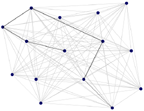
An Examination of Online Dance
"Abstract: The essay's opening section identifies the pioneering photographic work of Eadweard Muybridge as a catalyst for development in the cinema and technological industries during the twentieth century. This section also examines how key developments in both of these spheres, such as the emergence of a body of screen-specific dance work, and the growth of digital and new media arts practices, have fed into the genesis of online dance work as a potentially distinct genre. These elements are also examined in relation to the creation of Motion Studies (2003).
The essay's second section begins the process of inquiry into the nature of online dance work utilising a set of criteria developed by U.K. based choreographer Richard Lord. Using these criteria, a range of online dance content, such as promotional websites, webcasting and information databases are examined. These, however, ultimately fail to conform to the requirements for categorisation as online dance work. Five dance works created for Internet-specific presentation by British and U.S. artists are also examined and analysed as a means of determining properties or approaches common to the creation of online dance. The practical, artistic and technical issues involved in the creation of Motion Studies are also outlined in this section, including discussion of the role of the choreographer within current practice, and the importance of improvisation as an element within the piece.
The next section locates Motion Studies within the theoretical context of Donna Haraway's writings on feminism and the applications of advanced technologies, as outlined in Simians, Cyborgs and Women (1991). Haraway's concept of cyborg imagery is also examined in relation to the experience of choreographing and viewing Motion Studies, with a further examination of the enabling potential of technology as it relates to the creation and experience of viewing dance work. Wider issues in the current debate surrounding the use of technology in dance, as put forward by Don Ihde, Susan Kozel and Sherril Dodds, are also discussed.
In the essay's final section, a range of barriers to the creation of online work, such as lack of specialist technical skills within the dance community; the difficulties of attracting audiences, and the current emphasis on the commodification of dance, are examined. The issue of categorisation of online work is revisited, identifying several trends and similarities from within the sample study group, subsequently reaching the conclusion that it may not currently be helpful to insist on too rigid a definition of this type of work at such an early stage of its development. The essay concludes with a final evaluation of the processes involved in the creation of Motion Studies." From A node within a network: an examination of online dance work with particular reference to Motion Studies by Chirstinn Whyte (2003) [via Hyperchoreography]
Posted by jo at 09:42 AM | Comments (0)
January 30, 2006
Japanese Contemporary Dance Scene
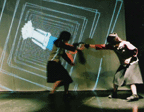
Dance and Technology, 2005
[posted by Yukihiko YOSHIDA] The most well-known video dance in TOKYO last year was "Chocolate" by Bokubroll (unit, Nibroll plus Boku-death). The work started with CG like Japanimation and sentimental music. Bodies in this work were choreographed by Mikuni Yanaihara. Dance critic, Yukito Kado called her movement "anti-modern dance complex." As he said, "Yanaihara sometimes rejects the traditional form of modern dance skillfully." At the same stage, an Australian dancer Luke George performed. The projected CG was the images of cow, the stereotype of Australia. The mood got better in this stage. As other groups, cell/66b did an excellent work. Tetsu, their video artist would be the best artist in this field. They used to work in Japan and Australia. Thus, their work also has trans-cultural background.
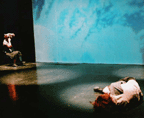
It can be said that “transculture” would be a keyword in Japanese dance scene. In addition, Sal Vanilla performed in Yokohama again. They had not been performed in Japan for years. The performers of Sal Vanilla are mainly from Butoh. Their works have environmental element and computer animations are projected to their body and whole space. Some Japanese artists try to choreograph body in space in the field of space development. They collaborate with JAXA (Japan Aerospace Exploration Agency). As a successful example, Japanese choreographer, Setsuko Ishiguro choreographed her work, “Hi-ten” (flying high sky) and released last year. In the field of communication technologies, the cell phone itself has been developing. In Akihabara, the image of Japanese animation character is in trend.
Photo: Nibroll, "Chocolate" by Takahashi (Nibroll)
Nibroll http://www.nibroll.com/
Sal Vanilla http://www.salvanilla.com/
JAXA: http://www.jaxa.jp/index_e.html
[posted by Yukihiko YOSHIDA]
Posted by jo at 09:42 AM | Comments (0)
Types and Challenges of Motion Tracking Systems
Matt Gough in his Splines in Space blog has two entries about the motion tracking and capture system he uses for his dance research and composition - Motion Capture (Dance) and Noodle Dance.
Matt describes the different types of motion tracking technology (Magnetic, Gyroscopic and Optical) and points out the challenges of tracking large numbers of discrete body movements. Ideally, he'd like to have a dancer outfitted with 100 plus markers and more computer power to process results in real-time.
An image that displays results of 1:41 minutes of motion tracking - "The Noodle Dance":
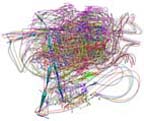
Using a passive optical motion tracking system with markers that are placed on the dancer's hands and body:
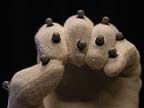
This area of motion tracking systems and dance movement - both for research and performance - is an area I plan to do a lot more interviews about both for my audio podcasts and upcoming publication. [blogged by Doug Fox on Great Dance]
See Motion Capture by Maureen Furniss and mocap notes ii.
Posted by jo at 07:44 AM | Comments (0)
January 19, 2006
Choreographing the Extended Agent:
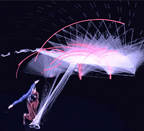
Performance Graphics for Dance Theater
"ABSTRACT:The marriage of dance and interactive image has been a persistent dream over the past decades, but reality has fallen far short of potential for both technical and conceptual reasons. This thesis proposes a new approach to the problem and lays out the theoretical, technical, and aesthetic framework for the innovative art form of digitally augmented human movement. Downie will use as example works a series of installations, digital projections, and compositions, each of which contains a choreographic component—either through collaboration with a choreographer directly or by the creation of artworks that automatically organize and understand purely virtual movement. These works lead up to two unprecedented collaborations with two of the greatest choreographers working today: new pieces that combine dance and interactive projected light using real-time motion capture live on stage.
The existing field of "dance technology" is one with many problems. This is a domain with many practitioners, few techniques, and almost no theory; a field that is generating "experimental" productions with every passing week, has literally hundreds of citable pieces and no canonical works; a field that is oddly disconnected from modern dance's history, pulled between the practical realities of the body and those of computer art and has no influence on the prevailing digital art paradigms that it consumes.
This thesis will seek to address each of these problems, by providing techniques and a basis for "practical theory"; by building artworks with resources and people that have never previously been brought together, in theaters and in front of audiences previously inaccessible to the field; and by proving through demonstration that a profitable and important dialogue between digital art and the pioneers of modern dance can in fact occur."
This thesis will achieve these goals because of its methodological perspective—that of biologically inspired, agent-based artificial intelligence—and the technical depth to which this idea is taken. The representations, algorithms, and techniques behind such agents are extended and pushed into new territory for both interactive art and artificial intelligence. In particular, this thesis will focus on the control structures and the rendering of the these extended agents' bodies, the tools for creating complex agent-based artworks in intense collaborative situations, and the creation of agent structures that can span live image and interactive sound production. Each of these parts becomes an element of what it means to "choreograph" an extended agent for live performance." --Choreographing the Extended Agent: Performance Graphics for Dance Theater by Marc Downie, OpenEnded Group.
MARC DOWNIE is an artist and artificial intelligence researcher. He holds degrees in natural science and physics from Cambridge and media arts from MIT, and a PhD from MIT's Media Lab. Downie's complex algorithmic systems are inspired by natural systems and a critique of prevalent digital tools and techniques. His interactive installations, compositions, and projections have presented advances in the fields of interactive music, machine learning, and computer graphics.
The OpenEnded Group creates digital artworks for stage, screen, gallery, and museum, with a present focus on art for public spaces.
The collaborating artists in the group are Paul Kaiser, Shelley Eshkar, and Marc Downie.
Kaiser and Eshkar have collaborated on numerous projects since the mid-1990s, pioneering the use of motion-capture and "hand-drawn" 3D spaces and figures in installation and dance works. Of these, perhaps the best known are BIPED and Ghostcatching. Also acclaimed is their first public artwork, Pedestrian, which projects trompe-l'oeil figures and miniature urban landscapes directly onto city sidewalks.
Joining them in 2001 to create Loops, Downie expanded the creative and technical vision of the group, adding artificial intelligence and real-time graphics to the mix. Downie has pioneered a new approach to generative music and imagery with a series of artworks entitled Musical Creatures.
Though the three artists largely work together, they sometimes work in pairs, create solo artworks, and pursue collaborative projects with others.
The OpenEnded Group works repeatedly with certain key collaborators (architect, composer, electrical engineer, programmers), whose bios may be found in the Collaborators section. [via andrew on Grand Text Auto] [Related]
Posted by jo at 08:04 AM | Comments (0)
January 16, 2006
MASTERS STUDY IN CHOREOGRAPHY
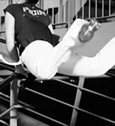
NEW MEDIA IN AMSTERDAM
MASTERS STUDY IN CHOREOGRAPHY/NEW MEDIA IN AMSTERDAM: OVERVIEW Established in 2002, Dance Unlimited (DU) Amsterdam is a unique two-year masters program* supporting the study of the relationship between choreography, performance and new media technologies. The program takes the development of choreographic work as its starting point, and new media technologies and practices are approached from this perspective. Theoretical and critical reflection is used as a means to challenge and support the practical work; and collaboration is emphasized. The DU staff comprises internationally known artists and researchers: Scott deLahunta, Sher Doruff, Jeroen Fabius (coordinator), Thomas Lehmen and Susan Rethorst.
CURRICULUM FORMATS: The program makes use of a wide range of curriculum delivery formats including: lectures, symposia, seminar, workshops, tutorials, reading and writing, mentoring and networking, studio-based research, etc. Within this a very active independent attitude is demanded from the student in the organisation of his or her own line of investigation. This 'independent study' comprises the main ingredient of the program.
CURRICULUM CONTENT: At the core of the curriculum is exposure to a range of new media technologies and practices overlapping with intensive choreography workshops. The aim is to develop sensitivity toward forms arising from the interplay between technology and choreographic practice. From here, students develop their own approach to practice based research and the making of artwork in a variety of formats. Introduction to possible collaborators and contexts for the presentation of finished artwork form another key part of the curriculum. In addition, the continuation of professional opportunities for the tudent after graduation remains an important concern throughout the two years with advise in this area provided on an individual basis.
FACILITIES AND TRAINING: DU Amsterdam accepts only four new students every two years, and this means access to facilities and staff is optimal. The program has its own dedicated rehearsal and computer studios and access throughout the year to the largest performance spaces in the Theaterschool. Elsewhere in Amsterdam there are several venues with which the program has a special relation, in particular the Melkweg Theatre, and students are assisted in showing their work in this wider public context. The program does not provide sustained training in complex hardware and software. The student is expected to come with a certain level of experience with the media they wish to explore and/ or be prepared to pursue a self-teaching path. As mentioned, students will be advised and supported in establishing collaborative connections with a range of partner organizations specializing in aspects of new media technologies and practices (e.g. such as Waag Society for old and new media, STEIM studio for electro-instrumental music and various media arts education programs).
FOR 2006-2008: We are looking for artists with a solid educational and professional dance background who wish to engage in a study of the relationship between choreography, performance, and new media technologies. However, we recognize that in areas of arts practice involving new media technologies such as locative media, robotics, and other non-screen based work an interest in movement and choreography may have come into play. As we re engaged in such overlaps, applications can be considered from candidates with these backgrounds who can give strong reasons for wishing to participate in a program that takes the choreographic mind/ body as its starting point and would be prepared to immerse oneself in collaborations with the other students who will have choreography and dance as their primary artistic practice.
APPLICATION DATES/INFORMATION
The program is ACCEPTING APPLICATIONS NOW for the September 2006 start. The application Deadline has been extended to 20 February 2006. A selected group will be invited for the audition in April. More general information and Registration Forms are available on this website.
CONTACT: Questions please contact the secretary: Ellen van Haeringen email: e.vanhaeringen[at]ahk.nl / tel: +31 20 527 7648 / fax: +31 20 527 7642
* Currently the program is postgraduate, but will be validated as a Masters from 2007
DU Amsterdam is part of a collaboration providing advanced study in choreography in the Netherlands with the Dance Academies of Rotterdam, Codarts and Arnhem, Artez.
Posted by jo at 10:23 AM | Comments (0)
January 03, 2006
Gameplay
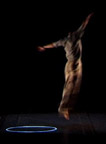
a ritual passage
Gameplay is an encounter between dance and programmed art: a ritual passage. Gameplay transposes the language and technology of video games to a choreographic environment where the dancer is confronted with challenges paralleling the notion of the physical test present in many rites of passage. Dance and the language of video games thus retrace common ground in a completely contemporary encounter.
The minimal visual language of Antoine Schmitt, author of the interactive levels, resonates with the tension of the choreographic writing of Jean-Marc Matos and Anne Holst in a staging where dance and the dancer find their raison d'être.
Antoine Schmitt has been exploring programming as an artistic material for more than 10 years, in a body of work that has been awarded internationally (including Unesco Video Danse 2003). The K. Danse company, composed of Jean-Marc Matos and Anne Holst, pioneers in the joint writing of choreography and technology (video and digital) for more than 15 years. Benjamin-Aliot Pagès trained in theatre, then in dance at the Rosella Hightower ESDC School and at the CDC, Toulouse, he has worked with many theatre directors and choreographers and also choreographs his own pieces.
Posted by jo at 02:07 PM | Comments (0)
December 01, 2005
Gameplay
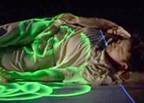
the dance body-machine relationship
From such a long time a dance and the electronic technologies have found a good connection, mostly in the use of motion sensors. These devices allowed the body to expand its movements beyond themselves, giving the body itself a role of a crucial node to external events, kinetically connected. But the sensors has become a simple short cut, humiliating the research for new interaction criteria between the organic dynamism and the electronic reaction speed. Gameplay by Antoine Schmitt, Jean-Marc Matos and Anne Holst is a project that tries to bring the language of early videogames in a choreography finding its link in both the domains' concept of physical test. The interaction between the performer's body and the illuminated forms that skim over it are emanating an affective aura. It's an interaction that reminds more the interaction fluidity of the organic forms than the univocal sensor's reactions. So a different dance grammar is compiled, enriched with new forms. These forms that set up a fluid symbiosis with the artificial light emitted in the body-machine relationship. [via neural.it]
Posted by jo at 11:49 AM | Comments (0)
November 28, 2005
Dance Unlimited (DU) Amsterdam
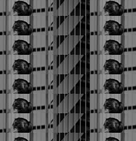
Choreography/New Media Program
Established in 2002, Dance Unlimited (DU) Amsterdam is a unique two-year masters program* supporting the study of the relationship between choreography, performance and new media technologies. The program takes the development of choreographic work as its starting point, and new media technologies and practices are approached from this perspective. We are looking for artists with a solid educational and professional dance background who wish to engage in a study of the relationship between choreography, performance, and new media technologies.
DEADLINE: 29 January 2006; CONTACT: Ellen van Haeringen: e.vanhaeringen[at]ahk.nl
Posted by jo at 12:41 PM | Comments (0)
November 09, 2005
Vivisector
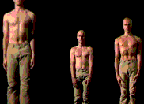
INTERVENTION IN THE SWEATING BODY
With Vivisector dance enters a new dimension in the latest collaboration between choreographer Chris Haring and cross-media artist Klaus Obermaier. Vivisector explores the physical and metaphorical possibilities of the human body, using projections to dissolve, alter and mutate the dancers' forms. Vivisector breaks the linearity of movement and in doing so shows the absurdity of momentum...Based on the video-technological concept of the moving body-projection that made D.A.V.E. an international hit, Vivisector now goes one step further: the exclusive concentration on video light and video projection produces a new stage aesthetic in which light, body, video and acoustic space form an unprecedented unity.
Tuesday 22nd November 8pm
Lakeside Arts Centre, Nottingham Tickets: £10/£7 concessions Box Office: (0115) 846 7777 www.lakesidearts.org.uk
Friday 25th November 8pm
The Junction, Cambridge Tickets: £10/£7 concessions Box Office: (01223) 511511 www.junction.co.uk
Sunday 27th November 8pm
Tickets: £6/£3.50 concessions Box Office: (01206) 500 900 www.colchesterartscentre.com in association with Essexdance
Artist Talk: Klaus Obermaier discusses his cross-disciplinary work Saturday 26th November 2pm The Junction, Cambridge Admission is free but due to limited capacity please call (01223) 511511 to confirm your place.
Posted by jo at 10:41 AM | Comments (0)
October 27, 2005
FAQ:
Postcoloniality, Transculture, and Dance Performance in Asia Pacific
[posted by Yukihiko YOSHIDA] FAQ: Postcoloniality, Transculture, and Dance Performance in Asia Pacific has been released. This list is written and managed by contributors. If you add research material, such as URL, name of document, etc., you will be added to
the contributor list.
Contributors: Ya-Ping Chen (TNUA, Taiwan), Yatin Lin (TNUA, Taiwan), Hsin-Chun Tuan (PhD. UCLA, USA), Yukihiko YOSHIDA (PhD. Candidate, Graduate School of Media and Governance, Keio Univ, Japan), Yuji Sone (Vice-Chancellor's Postdoctoral Fellow, School of Media, Film and Theatre, The University of New South Wales, Australia-Japan), Mariana Verdaasdonk (66b/cell, Australia-Japan), Julie Dyson (Ausdance National, Australia), Teresa Pee (researcher/educator, Singapore), and Urmimala Sarkar Munsi (WDA Bengal, India).
Posted by jo at 11:13 AM | Comments (0)
October 13, 2005
Inside

Brain Wave Projections of Dance Performers
At the September Ingenuity Festival or Art and Technology in Cleveland, Ohio, MorrisonDance performed a work, Inside, that integrated projections of real-time EEG (electroencephalograph) brainwave readings of the dancers and a pre-recorded video of Sarah Morrison's arthroscopic elbow surgery. For the brain reading component of the performance, Morrison wore a brainwave-reading FlexCap developed by BrainMaster Technologies. [Posted by Doug Fox on Great Dance]
Posted by jo at 11:06 AM | Comments (0)
October 10, 2005
Ballettikka Internettikka:
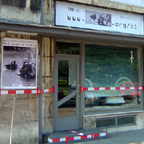
BEO Guerrillikka in Belgrade
Ballettikka Internettikka: BEO Guerrillikka [Bureau NetBallet] by Igor Stromajer & Brane Zorman (Belgrade, Serbia, 2005) (live internet broadcasting); Thursday, Oct 13th, 2005 at 9 PM GMT+1 (Berlin/Paris/Belgrade local time); Duration: 20 minutes (time tolerance: +/-4 minutes); Location X, Belgrade, Serbia; # Latitude: 44.79345 N, Longitude: 20.45340 E, Terrain Elevation: 110 m; Location will be made public on Oct 13th at 8:50 PM GMT+1 (10 minutes before the performance starts; due to security reasons).
Ballettikka Internettikka is an ongoing artistic study of the internet guerrilla performance. After invading the Bolsh.oi Theatre in Moscow (March 2002), and La S.cala in Milan (November 2004), Stromajer and Zorman will perform a new guerrilla net ballet, this time in another theatre house in Belgrade, Serbia.
Live internet broadcasting of the net ballet performance will start on October 13th 2005 at 9 PM GMT+1 and will last 20 minutes (+/- 4 minutes); the location will be made public on Oct 13th at 20:50 GMT+1 (10 minutes before the performance; due to security reasons).
They will enter the office (brain center) of the Artistic Director [location X], here the hardest artistic decisions to run the institution are taking place. The artists will use remote-controlled toy-robots with wireless web cameras.
Watch and listen live to internet guerrilla bureau ballet at http://www.intima.org/bi/beo
(Oct 13th 2005)
Artists will use low-tech mobile and wireless equipment for the invasion and live broadcasting (portable computers, mini digital camera, MP3 audio systems, mobile GPRS telephones etc). A laptop and MiniDV cam, together with Webcam32 (version 6.0) software will be used for broadcasting the video signal (running over Intima Virtual Base FTP server). Another laptop and MP3 player with online interface SHOUTcast (version 1.8.3/win32), will be used for live sound broadcasting (running over Beitthron FTP server). A local GSM mobile phone operator will be used for GPRS mobile internet connection.
Action Timetable / Belgrade, Oct 13th 2005 / GMT+1:
20:55 Equipment check on the parking place in front of [Location X]
20:57 Turning the computers on
20:59 Establishing wireless Internet connection (GSM 900/1800)
21:00 Start of live Internet broadcasting (-2) and final equipment check
21:01 Entering the building of [Location X]; climbing the stairs--3rd Floor (-1)
21:05 Entering the office of the Artistic Director [X] (3rd Floor / left): (0)
starting live bureau net ballet (10 min)
21:15 End of live bureau net ballet: exiting the office; descending the stairs (+1)
21:19 Exiting the building of [Location X]
21:20 Terminating wireless Internet connection at the parking place outside
[Location X] and turning off the computers (+2)
21:22 Taking the taxi to the O3ONE Gallery
Dancing a wireless bureau net-ballet in the office of the Artistic Director location X] represents a big conceptual and strategic challenge to the Intima Virtual Base, therefore the preparations have been taken serious, safety measures have been calculated, and the previous experience from the Bolsh.oi Theatre in Moscow and La S.cala in Milan has been very welcome.
Ballettikka Internettikka: BEO Guerrillikka is supported by Municipality of Belgrade, Ministry of Culture of the Republic of Slovenia, Ministry of Culture of the Republic of Serbia, O3ONE Gallery in Belgrade.
Bureau NetBallet Operators: Igor Stromajer & Brane Zorman
Bureau NetBallet Composer: MC Brane vs. BeitThroN vs. Thronus Sound System
Theoretical Adviser: Bojana Kunst
Curator: Ana Vujanovic
Executive Producer: Jelena Knezevic
Computer Programming: SM NORT
Co-produced by Intima Virtual Base (Slovenia) and TkH Center for the Theory and Practice of Performing arts (Belgrade)
[] [] []
Ballettikka Internettikka was presented in noumerous galleries and museums of contemporary art worldwide (from 2002 to 2005) including Le Centre national d'art et de Culture Georges Pompidou - Musee national d'art moderne in Paris, 15. Stuttgarter Filmwinter in Stuttgart, Centro em Movimento in Lisbon, FILE 03 - electronic language international festival in Sao Paulo, Titanik Gallery in Turku (Finland), P-10 Gallery in Singapore, IMPAKT festival in Utrecht (The Netherlands), Thailand 3rd New Media Arts Festival in Bangkok, Cork Vision Centre - Cork Cultural Capital of Europe 2005 (Ireland) and CEC ArtsLink in New York.
[] [] []
About the authors:
Igor Stromajer
http://www.intima.org
is an mobile intimate communicator. He researches tactical emotional states and traumatic low-tech strategies. He has shown his work at more than a hundred exhibitions in forty-two countries and received a number of awards. His works are included in the permanent collections of the Centre Georges Pompidou, Paris; the Museo Nacional Centro de Arte Reina Sofía, Madrid; Moderna galerija Ljubljana, Slovenia; Computerfinearts Gallery, New York and others.
Brane Zorman
http://www.ljudmila.org/beitthron
is a composer and sound manipulator. Between 1982 and 1986 he was frontman for the Slovene punk group O!KULT. He is a pioneer of Slovene techno scene. Since 1987 he has been composing music for both Slovene and international theatre, dance and multimedia performances and projects. and has made guest appearances throughout Europe. Recently he works with Irena Pivka on a series of audio-visual installations ZONE.
Intima Virtual Base - Institute for Contemporary Arts
Belgrade: +381 64 4200614
Slovenia: +386 41 703291
igloo [at] intima.org
Posted by jo at 11:15 AM | Comments (0)
October 07, 2005
Great Dance Weblog

Dance and Technology Resources
"Welcome to the first edition of our Dance and Technology Resource Guide. Please email Doug Fox to make additions and edits. In your email, include the resource name, link and description. Also, please include your contact information (name, email address and affiliation, if relevant).
Table of Contents: 1. Dance Companies, Performances, Installations and Practitioners 2. Dance on Camera and Movies 3. Conferences, Symposia and Courses 4. University/Academic Programs, Projects, Research Centers and Studios 5. Software and Technology 6. Games, TV Shows, Interactive Applications and Commercials 7. Dance Documentation and Preservation 8. Articles and Academic Papers 9. Online Discussions and Blogs."
Posted by jo at 10:35 AM | Comments (0)
September 30, 2005
motione
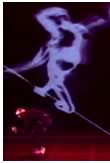
Bridging the Phyical-Digital Divide
motione: Using state of the art, real time motion capture technologies and motion analysis techniques, the movement of the dancers and the structures of the choreography are analyzed in real time. Through novel artificial intelligence and human-computer interaction systems, the results of the analysis informs the creation of digital graphics and sound environments that react to, accompany, enhance and comment on the choreography.
The works investigate future possibilities for interactive art works while exploring the effects of the new digital sensing, processing and creation possibilities on the human condition. They propose integrations paths that will allow these technologies to enhance and promote humanism.
The motione project of the Arts, Media and Engineering (AME) program at ASU, brings together choreographers Trisha Brown and Bill T. Jones; media artists Paul Kaiser, Shelley Eshkar and Marc Downie; composers Roger Reynolds and Curtis Bahn; lighting designer Robert Weirzel with AME artists and engineers for the creation of two ground breaking, interactive multimedia works, new motion analysis systems and interactive technologies. motione premieres on April 9th 2005 at ASU 's Galvin Playhouse.
motione is a joint project of the Arts, Media and Engineering Program through the Herberger College of Fine Arts, the Fulton School of Engineering. It is co-presented by ASU Public Events. We are grateful for support from the National Endowment for the Arts, the National Science Foundation, Motion Analysis Corporation, Lincoln Center, Arizona Public Service (APS) and City of Tempe Cultural Services.
[...]
The physical-digital divide in art
Today, a large percentage of content that is shaping our society reaches us through digitally enabled media (computers, cell phones, TV, movies). Yet, the majority of the established arts, creation, education and presentation communities concentrate solely on physical art manifestations presented in traditional venues (theaters, concert halls, galleries).
We still struggle to find effective ways to connect new forms of digital content to the maturity and sensitivity of traditional art forms. Addressing this divide by successfully integrating physical and digital art forms could raise the level of digital content and end the marginalization of traditional art.
The physical-digital divide in life
Our civilization is currently undergoing major changes. Traditionally, human beings acquired knowledge through experiential interactions with the physical world. That knowledge allowed them to better adapt to their reality and evolve.
Today, the electronic networked world is rapidly becoming an integral aspect of human reality. Our interactions with almost every element of our lives, from the weather, to our habitat, our bodies, our friends and relatives involve computation and mediated information.
However, as any dictionary would point out, knowledge results from experience. To adapt to this new world, we must bridge the gap between computational information and physical experience. We need unified experiences of the physical and computational forces that are shaping our reality.
Integrating the physical and the digital at multiple levels and dimensions
We experience the world concurrently at many different, interconnected levels, from the level of manifestation, to the level of operational structure and the level of semantics. It follows that a convincing physical-digital experience must be integrated at all those levels. All participating elements must contribute to a structurally, aesthetically and semantically coherent experience.
We also experience the world at multiple levels of time. Real time perception, short term memory, long term memory and social memory contribute to our experience. Our structural, aesthetic and semantic integrations must hold true across the multilayered dimension of time.
Finally, we experience the world in an interactive manner where our actions explore and influence our environment. Integrated physical-digital experiences require interactive digital media that allow for exploration while exhibiting adaptability.
Digital media are based on computation and our current society is deeply intertwined with computational infrastructures. It follows that structural integration of digital media into the physical world would have to rely on computation.
Creating embodied hybrid experiences
The music and visual arts communities have been working for the past two decades on creating hybrid physical digital music compositions, visual art works and installations. However, human experience of the world is embodied and multi-modal. Arts can best investigate and depict our current hybrid reality through multi-modal, interactive works that include movement. The main drawback for such works has been the difficulty of digitizing and analyzing movement.
Sampling, digital analysis and digital synthesis of sound and image are already fairly advanced. Complex processing of sound and image can be realized with good accuracy in real time. User-friendly software for interactive analysis and synthesis of sound and image are readily available.
Some of those packages (i.e. Max/MSP/Jitter) allow for the simultaneous processing of both image and sound. The tools for coherent, digital, sound-image interactive compositions are available and increasingly used in all types of settings--from installations in galleries, to jam sessions in music bars, symphonic concerts, educational settings and biodesign experiments.
Documentation and analysis of motion has until recently relied on 2D video capture that provides limited information on the spatial and kinesthetic aspects of movement and has limited capabilities in real time use.
The development of motion capture technology in the past two decades has opened up many possibilities for advanced digitization and analysis of movement. The motione project is developing techniques for advanced real time capture and analysis of movement. These motion analysis systems are being integrated with real time systems for image and sound analysis and synthesis to create unified platforms for the creation of multimodal physical-digital works. [...]
Posted by jo at 11:00 AM | Comments (0)
September 29, 2005
"EVE’s Pore" Koichi WATANABE
Pop Meets Cyborg
[Blogged by Yukihiko YOSHIDA] Koichi WATANABE, known for his unique work molding famous people's body in plaster, collaborated with dancer, Rumiko BESSHO. BESSHO’s statue as full-body-model and video art were placed in the gallery’s white space. In the video, she is completely naked. Her body seems to have an aura of a real body in spite of the image's virtuality. BESSHO appears from backwards and move slowly and dance sharply with piano sound. At the beginning, she was in the same posture as a plaster statue. The statue looks like a mold of her body.
Then she began to move little by little looking carefully her inner side. In the video art, BESSHO was naked. Her images were projected on white costume and it looked erotic. However, white statue’s existence looks real on the other side. As BESSHO turns slowly and slowly, white cloth was involved to her body little by little. Her movement is not dramatic but sharp and free. From Kazuo
OHNO to Akaji MARO, WATANABE makes famous persons’ plaster models widely. On this exhibition, WATANABE also displayed statue by plaster which took the model of “Rika-chan doll” and "Kyupi doll." It looks like pop and a bit Akiba-style. Takashi MURAKAMI’s concept, "super flat" was shocking to Art World and Japanese figure dolls got more and more popular. These dolls are more OTAKU than Rika-chan and Kewpi doll, which is also popular in Japan.
They are pop, but they are artificial like cyborgs which you can see in SAC 2nd GIGS. BESSHO’s statue is more humanistic than these figures and cyborgs. From the point of view of performance, it looks successful and I am looking forward to seeing her next step. BESSHO’s 3 types of body, statue by full-body-model by plaster, full-naked body image in the video art, and BESSHO as a real dancer, represent artificial Japanese-ness and existence in the 21st century.
Related Webpages:
Rika-chan: http://www.takaratoys.co.jp/licca_chan/
Takashi Murakami: http://www.kaikaikiki.co.jp/
SAC 2nd GIGS: http://www.kokaku-s.com/root.html
Posted by jo at 07:18 AM | Comments (0)
September 19, 2005
Troika Ranch
![]()
Live-I Workshop
New York City based dance theatre company Troika Ranch returns to FACT to present its live Interactive (Live-I) workshop, an intensive seminar for artists and advanced students who want to explore the use of interactive computer technology in the creation and performance of dance, theatre, and related live artworks.
Led by composer/programmer Mark Coniglio and choreographer Dawn Stoppiello, Artistic Co-Directors of Troika Ranch, the workshop gives the participants the opportunity to experiment with technological tools that allow their gestures and vocalizations to interactively control video, sound, light and other computer controllable media.
The three day workshop at FACT will serve as an intensive introduction to the software and hardware, with special emphasis on Isadora®, the real-time media manipulation software created by Coniglio. This work will be complemented by critical discussions regarding how the use of media and technology shapes the form and content of the artwork.
FACT, Liverpool; 31 October - 2 November 20053 days, 10.30 - 5pm, cost £105 + VAT.
Posted by jo at 10:00 AM | Comments (0)
September 12, 2005
Rondo
Interactive and Intercultural Experience
[Posted by Yukihiko YOSHIDA]: Group Motion and Leni-Basso are currently involved in a collaborative multi-media dance project. This project is funded by the Japan Foundation, Dance Advance, Philadelphia, Arts Midwest, Ohio, The US Japan Friendship Commission, Washington, Indiana University of Pennsylvania and Montgomery County Community College, Pennsylvania, WIDE Project, Research institute for Digital Media and Content, Keio University, Yukihiko YOSHIDA.
Rondo will premiere here in Pennsylvania in September of this year and will hopefully be shown in Tokyo in the Fall of 2006 during the 'Dance Selection' Festival where Group Motion also performed in 2003. During our final production week of Rondo, September 14-19, we are planning to have an Internet2 conference in which we will broadcast a rehearsal of the piece live over the internet and have live discussion and interactive exchange with a group of interested people in Tokyo. It will be a wonderful opportunity for performers, critics, and lovers of dance to be involved in an interactive and intercultural experience that is taking advantage of advanced internet technology in a new way as an educational and informational tool.
There will be a designated facilitator and a translator (tbd) on each side. The translator in Tokyo will be Mikari Suzuki.
Date: September 16, 2005
Starting Time: 6:00 a.m. Philadelphia, 6:00 p.m. Tokyo.
Place: Keio University Mita Campus, East Building 6F GSEC Lab
http://www.gsec.keio.ac.jp/
Supportors: the Japan Foundation , Dance Advance, Philadelphia, Arts Midwest, Ohio, The US Japan Friendship Commission, Washington, Indiana University of Pennsylvania and Montgomery County Community College, Pennsylvania, WIDE Project, Research institute for Digital Media and Content, Keio University, Yukihiko YOSHIDA.
Posted by jo at 11:03 AM | Comments (0)
September 01, 2005
Behind the 8-Ball:
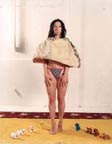
Sarah Michelson
"Yesterday, winding my way through the new Walker, I witnessed what must’ve been choreographer Sarah Michelson’s dancers rehearsing for the performance of Daylight (For Minneapolis). As Michelson is notoriously tight-lipped about revealing details on her performances beforehand, I can’t give anything away. But expect surprises (and perhaps a stone-still dancer with a Walker Shop bag over her head). Still, as the description of her September 15-18 performances leaves just about everything to the imagination–”a dance/installation experience inspired by the design of the Walker’s new building”--perhaps a look at her earlier works can offer an inkling.
In a 2003 performance at the Kitchen, typical audience/performer relationships were reversed. Viewing bleachers were on stage, facing out, and when the performance began, the house lights went up, not down. Artforum describes what happened next: “[T]he doors to the Kitchen swung open instead of shut, and all the way, across the street, two spotlit dancers in bright yellow tunics walked in unison down three steps of the building opposite and danced, in small side-to-side motions, into the performance space itself.”
For Part I of Daylight, presented at PS 122 in June, she placed “the audience in a kind of box, with the musicians behind them, and leaving a performing space that was only about twelve feet deep,” wrote Joan Acocella in The New Yorker. “This show was one of the strangest things I have ever seen. The four dancers entered through an upstage passageway that looked like something from Dr. Caligari's house. They then launched into a carefully rehearsed, largely unison dance that was traditional in one sense--it was done on the music--and in no other.”
And in a choreographic commission for Baryshnikov and his White Oak Dance Project, Michelson “costumed the ballet legend in Velcro handcuffs, gold chains and an ankle-length, see-through Chanel skirt, and set him to dance on a stage carpeted in bubble wrap. Such is her eclectic idea of elegance, never too pristine,” wrote Art in America.
Or maybe her personality, or as much of it as comes through an eight-question artist questionnaire, can offer some ideas about what to expect. In the September issue of Walker we ran our usual 8-ball Q&A with her. Here’s another eight:
What's the last (or favorite) book you read?
Experience by Martin Amis
If you could throw a dinner party for anyone in the world, who would you
invite?
Tonight? Parker Lutz [a dancer in Michelson’s company].
How do you like to unwind/relax?
Bath, sleep.
If you could change one thing about yourself, what would it be?
Cellulite. My bank balance. My loneliness.
What artists are you most interested in at the moment?
How does one answer a question like that?
What is your favorite euphemism?
Bathroom.
Who is your favorite villain of fiction?
Keith Talent [Protagonist in Martin Amis’ London Fields]
What question do you wish we asked you?
The answer is: grace is crucial.
No closer to understanding? Me neither. I guess we’ll have to show up and see for ourselves…" [blogged by by Paul Schmelzer on Off Center]
Posted by jo at 12:04 PM | Comments (0)
June 24, 2005
16 (R)evolutions
evssmall.jpg)
Exploring Polarities
16 (R)evolutions is a work in progress that can be seen for the first time in the UK at Colchester and in Chelmsford. It combines dance, theatre, and interactively generated video imagery to explore the polarities of being animal and being human; the former being dictated solely by the need to survive and reproduce, the latter being a state of confusion created when these basic instincts are blurred by intellect. Technologically Troika Ranch's Isadora software is integrated with EyesWeb to allow the dancers to create and manipulate three dimensional imagery as they perform. In the winter of 2005 the English company will be travelling to New York to complete work on 16 (R)evolutions and present the premiere of the completed work in New York City.
Posted by jo at 11:20 AM | Comments (0)
April 26, 2005
Video Conferencing Software as a Performance Medium

Is There No There There?
"ABSTRACT: This paper surveys past performances in which the author collaborated with several other dancers, musicians, and media artists to present synchronized co-located performances at two or more sites. This work grew out of the author's participation in the landmark computer music ensemble, "the HUB". Each of the various performances were made possible by an evolving array of video conferencing hardware and software. These will be discussed. The problems and interesting side effects presented by latency and dropouts are a unique part of this performance practice. Leveraging the concepts of shared space, video and audio feedback generate evolving forms created by the combinations of the space, sounds and movements of the participants. The ubiquity of broadband Internet connections and the integration and constant improvement of video conferencing software in modern operating systems, makes this unique mode of performance and essential area of research and development in new media performance." From Video Conferencing Software as a Performance Medium by Scot Gresham-Lancaster.
Posted by jo at 10:31 AM | Comments (0)
April 20, 2005
InterPlay: Loose Minds in a Box
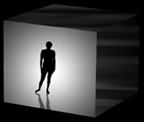
Six by Six
InterPlay: Loose Minds in a Box is a collaborative work that explores the basic concept of the "box". The box is a metaphor for the physical, social, political or psychological constraints that we and/or others place upon us. The box also represents a sense of place in the realm of the virtual as well as in our sub-conscience. InterPlay is a multi-faceted telematic event that consists of six simultaneous performances that occur in six states throughout North America. The performances incorporate theater, text, music, performance art, virtual reality, and motion capture and are concurrently captured, mixed, digitized, encoded and streamed onto the network.
Posted by jo at 08:42 AM | Comments (0)
April 14, 2005
Trisha Brown
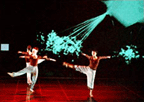
Dance With Electrons
"In this mysterious new piece, how long does the subject linger at the edge of the volume . . . . , the movement of the dancers generates digital signals that visual artists, working in real time, transform into cloudlike or striated shapes—imagine the strings of a parachute, or of marionettes, afloat in space—playing on a scrim at the front of the stage. Composer Curtis Bahn, who teaches at Rensselaer Polytechnic Institute in Troy, NY, and lectures on electronically extended instruments, dance, and performance technologies, uses the same data to create the accompanying sound, transforming raw material from acoustic instruments. When the dancers slow down, he reckons, the music will get busy." From Trisha Brown's Dance With Electrons Arrives at Lincoln Center by Elizabeth Zimmer, Village Voice, April 8th, 2005.
Posted by jo at 09:17 AM | Comments (0)
April 08, 2005
man in [ e]space.mov

Cine[mato]graphy and Choreography
The performance man in [ e]space.mov--by Wolf Ka--questions the representation of the body by declining the relationship between electronic space and man by merging two forms of writing the movement: the cine[mato]graphy and choreography.
The performance bases on techniques that marked the beginning of the cinema and which has introduced a new reading of the moving body: the reduction and abstraction of the human body and the decomposition of its movement in 24 images/second is in this creation assembled and recomposed in 3D space. This process, undertaken in particular by Marey and Muybridge is renewed here with the introduction of electronic and digital technologies.
As the title already suggests the performance directly refers to the experimental German cinema and dance of the 20th examining the notion of bodyspace according to the machine and its aesthetics. From Etienne Jules Marey cinematic work to the experimental work of artist such as Oskar Schlemmer and Oskar Fischinger they followed a systematic and radical way proposing a perspective of the body on stage as an abstract and symbolic representation as opposed to the psychological and expressive approaches. According to their choreographic and cinematic work, Man in e.space.mov pursuit these researches while confronting it to digital media, in between choreography, cinematography and scenography _ in between dance, music and architecture.
Having the same starting point the performance Man in e.space.mov is based on the complete reduction of space and body, a complete black space where the dancer is reduced to lines constituted through a light costume outlining the body articulation. A camera films the invisible moving dancer on stage, the lines in time, while capturing only 2 frames per seconds. These captured images are placed inside a 3d space which is projected in the back of the stage. Each sequence new images are added, thus building up slowly a strip-man like animation out of the captured image. Once reached 24 frames/s the formed strip-man juxtapose to the performer on stage and thus construct a second ‘virtual’ dancer. Through this juxtaposition a dance, a movement, is constructed in between the dancer and its own images. On one hand the cinematic construct is directly derived from the dancer’s movements but the temporal programming also constitutes an unpredictable parameter giving autonomy to the self residual image. The result is not only a superposition of the image to the body but also from the subject to the object.
Posted by jo at 04:12 PM | Comments (0)
Storytronics
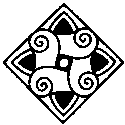
Dance and Deep Hypertext
Some Hypertext researchers pointed out the relationship between Hypertext and Dance, these years. Australian Hypertext researcher, Katherine Palps, invented the concept, Storytronics. This concept means that Hypertext and structure of myth. Like semiology by Vladimir Propp, Palps constructed the simple structure of myth and accommodated that to universe of Hypertext. With her experience of teaching in her class at Melbourne University, she found student who learn dance or architect can understand this concept easily because of dancer's three-dimensional cognition. Palps pointed out that dancers are easy to understand multi-dimensional Hypertext.
(Palps invented the concept "Ping Body" for Australian media performance artist STELARC. This concept is known as the title of his work in 1996. Her husband Andrew Pam is working as a chief programmer of Project Xanadu, the original Hypertext project by Ted Nelson.) Some important suggestions are came from engineers. A hypertext research group works with a dance researcher Janet Lansdale. (Miles-Board, Timothy and Deveril, and Hall, Wendy and Lansdale, Janet (2003) Decentering the Dancing Text: From Dance Intertext to Hypertext.)--by Yukihiko YOSHIDA
Posted by jo at 09:26 AM | Comments (0)
March 24, 2005
John D. Mitchell + ADaPT
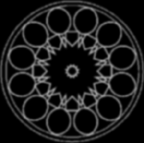
Expanding Sensory and Creative Experiences
John D. Mitchell is a multi-disciplinary composer, educator and researcher committed to using technology for expanding sensory and creative experiences in the arts and education. He has worked with artists from around the world to design and realize projects ranging from multimedia dance archives to interactive multi-site distributed performances.
ADaPT, initiated in December 1999, was the brain child of Mitchell while working under the auspices of the Institute for Studies in the Arts at Arizona State University. ADaPT originally included researchers and information technology specialists from five institutions: Arizona State University, The Ohio State University, The University of California, Irvine, The University of Utah, and The University of Wisconsin, Madison. Over the years ADaPT has expanded to include partners in other countries on four continents.
In 1987, Mitchell and choreographer Gary Lund created Movement Initiated Sound Events (MISE), one of the earliest dance works to use a personal computer and optical sensors for creating a completely interactive, performer driven sound score. Over the next three-years Mitchell and Lund produced several dance-driven, interactive multimedia works for the stage, often collaborating with visual artists and live musicians.
Upon joining Arizona State University in 1990 Mitchell became a founding member of the Institute for Studies in the Arts. At the Institute, Mitchell was instrumental in pioneering the development of the Intelligent Stage – both as a concept and a facility – where he continued to work for the next ten years as a composer, director and interactive media designer. Mitchell has collaborated with numerous artists to create performance works that have been staged throughout United States and abroad.
Mitchell currently directs the graduate emphasis in Dance and Technology and teaches interdisciplinary media and telematics courses in the Department of Dance at Arizona State University. See Using Human Movement to Control Activities in Theatrical Environments by Robb E. Lovell and John D. Mitchell.
Posted by jo at 12:56 PM | Comments (0)
March 21, 2005
W.icked W.orld W.ithin

Mixed Realities
Participation lies at the heart of this extraordinary work, offering spectators a rare chance to watch in close proximity to the dancers. Every show is unique and the on-stage audience gets the chance to influence how the piece evolves using special interactive touch pads in the floor.
Inspired by one of the most complex systems supporting human life – the immune system - W.icked W.orld W.ithin, by Ijad Dance Company, is a captivating new dance installation that celebrates and questions the body’s internal logic in its reaction to affliction. Investigating the role of consciousness and memory in the body’s will to survive; what it chooses to accept; what it fights to reject, w.icked w.orld w.ithin [www] is insightful and revelatory.
w.icked w.orld w.ithin is a synthesis of movement and image brought about through collaboration between the fields of choreography, design, digital technology, bio-science, microscopy and projection.
Presented within a specially conceived, adaptable hemispherical set that houses a dynamic visual environment and performed by a company of seven dancers, the production allows technology and artists to interact. This interactive sphere, where body motion, responsive technology and science recreate the fascinating inner world of the human body, promises audiences an evening of rich, sensory experiences; of movement that is both vital and joyous and sensation that is both virtual and real.
IJAD: Contemporary dance with media technology. Founded in 1995 by Joumana Mourad, IJAD Dance Company develops innovative and dynamic concepts within dance, moving with the times and developing work where there are no limits between dance, space, film and technology. The results are highly defined signature performances, the originality of which challenges audiences’ expectations of dance presentation.
Joumana holds a Diploma in Dance Studies from the Laban Centre for Movement and Dance and an MA in Dance and Choreography from Middlesex University. To date, Joumana has created 6 productions for IJAD as well as choreographing for Jumeira Productions, Piedo Dance Company USA, Polite Company, the National Youth Music Theatre Company and US advertising agency Big Photographic.
Joumana has taught contemporary, jazz and creative movement classes at Lewisham College, Living Well Health Clubs and various schools and community centres throughout London. She is also a filmmaker who has created two short films, A Point of No Return and most recently, A Blind Eye Turned, which was filmed entirely underwater in the Lebanon. A Blind Eye Turned, which forms part of IJAD’s production Pas de CinQ, was screened as part of Dance on Screen Festival at The Place Theatre, London in November 1999. She is currently engaged in leading a Dance Advance dance and technology workshop at essexdance on 27th March 2004.
Posted by jo at 09:56 AM | Comments (0)
March 08, 2005
dotdotdot
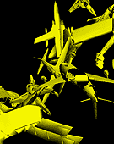
Glimpses of Unseen Places
A landscape from beyond the edges of the browser window that gives glimpses of unseen places. dotdotdot is constructed using several different motion capture systems and improvised performances creating abstract digital portraits. These animated avatars move and react to players inputs within an online virtual environment.
"dotdotdot provides a good example of the ways in which practitioners using old media and new media can collaborate to produce an ongoing body of work challenging the canons from which each component of the work orginates. Using motion capture, web tools, animation, games engines, sound and movement dotdotdot presents a series of animated interactive vignettes. These can be manipulated in terms of speed, sound, rotation and movement so that the basis of the range of visuals on offer stays the same but also so that the viewer/player can change them to accommodate their own preferences. [via Rhizome]
Each work has an Igloo signature but it allows the viewer to manipulate, play and be creative - after years of artists striving for truly interactive work, dotdotdot knowingly works with the limitations of interactivity in order to give the piece a characteristic style.
The viewer/player is presented with a range of choices involving genre orientated radio stations (you can choose drum & bass through to chart music) and a variety of visuals such as red, dot, bendy and plane. All these permutations and combinations together with the ability to interact with the animated figures in terms of speed and rotation challenge the viewer to think about the visual and audio styles in relation to their own experience of video, sound, animation and movement drawn from a variety of sources in day to day culture.
The project, which has been ongoing, is the product of Ruth Gibson, a dancer who is specifically looking at development of movement in the context of motion capture, and a programmer Bruno Martelli, who is interested in pushing the limits of technology in real physical contexts. The artists draw in expertise and collaborators as and when they need and the quality of the work is enhanced with every reworking. Their animations reflect these concerns with their 3D quality combined with recognisability of the human form in spite of the abstractness of the animated shape." Helen Sloan, Director - SCAN
Posted by jo at 07:38 AM | Comments (0)
March 07, 2005
DIGITAL CULTURES
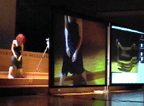
International Dance Technology-Lab 2005
The International Dance Technology-Lab 2005 will take place from 28 November - 4 December; it will be hosted by Nottingham Trent University's Future Factory in cooperation with Radiator Festival for New Technology Art, essexdance and other UK partners. The weekend conference and exhibition events are open to all.
Digital technologies challenge our techniques of dance and performance, customary perceptions of culturally embodied knowledge and sensory processing, and assumptions about choreography, composition, and the relations between maker, performer, and audience.
The central aim of this international lab meeting in November-December 2005 is to take stock of the evolution of contemporary dance (technology), and develop a new understanding of interaction design and physical computing in the dance and performance field through critical engagement with the consequences of interactivity on contemporary digital cultures.
We shall ask: whether interactive performance has become an instance of collaborative culture, beyond aesthetic conventions of concert dance, and how interactive media blur distinctions between performer and audience/user, between performance, play, ritual, game and utility.
Western knowledge of digital interactivity is examined through non-Western concepts of interaction. Non-western articulations of the digital provide a framework for fresh interpretations of participatory design. The cultural questions in this research lab derive from observations of multi-level collaborations between artistic, theatrical, technological, and research partners from different cultural backgrounds and locations, as well as from lab experiments with divergent perceptions of the sensory processing of the digital.
The theoretical scope of the project encompasses an analysis of "digital cultures" in interactive dance based on the findings of an international and cross-cultural lab with the participation of 20 or 25 distinguished choreographers, composers, performance and media artists, programmers, and designers. The lab workshop takes place at Nottingham Trent University over a period of one week and is closed to the general public.
The weekend conference and exhibition events are open to all.
Cross-cultural perspectives and digital art are the focus of the concluding Public Roundtables and Colloquium to be held at this confernece (Friday through Sunday, December 2-4, 2005).
Commissions for new work will be announced, and these will be on display throughout the week. The colloquium is organized in collaboration with the Radiator Festival for New Technology Art. If you wish to make a presentation on the subject of the Lab during the conference, please send us a proposal.
johannes.birringer @ ntu.ac.uk
Live Art - Digital Research
Nottingham Trent University
Victoria Studios - Shakespeare Street
Nottingham NG1 4FQ UK
http://art.ntu.ac.uk/performance_research/birringer/idat.htm
Posted by jo at 07:25 AM | Comments (0)
February 25, 2005
Multimedia Performance after Dumb Type
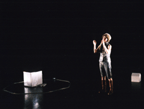
New Movement Emerges
In 90's, Dumb Type established multimedia performance in Japan. Teiji Furuhashi and Dumb Type in early 90's were legend of Japanese Multi Media Performance and Media Art for their works, for example, "S/N"(Dumb Type) and "Lovers"(by Teiji Furuhashi).
In this season, I have a presentiment of stages after Dumb Type. There was a competition called Yokohama Solo X Duo Compe'tion + R at the end of January. This competition has a relation with a French famous competition called "Recontres Choreographique Internationales de Seine-Saint-Dennis." [posted by Yukihiko YOSHIDA]
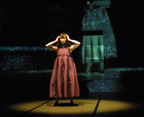
In this competiton, there are many multimedia Performance and performance with robotics. Thee winner of this competition, Mariko Okamoto, used interesting robotics in her piece. A young Japanese girl sits down on a small refrigerator and moves little by little. Small robotics move beside her on the stage. One of the dancers, such as Mariko Kon'no, whom I introduced in this blog before, danced sharply with video art by Haruo Higuma, who is a well known artist in this
field.
A very successful work is "Alicetopia" by Satoko Yahagi in early February. Yahagi got an idea from a picture book "Alicetopia." Yahagi's dance and choreography are under the influence of Surrealism. The aestheics of Surrealism arranged the visual effect of this work. I have a presentiment of a new movement after Dumb Type after seeing this work.--Yukihiko YOSHIDA
Photo Credits:
French Embassy Prize for Young Choreographers Mariko Okamoto, "sputonik*gilu" Photo:Yoi'chi Tsukada
Satoko Yahagi,"Alicetopia", Photo: Kei Yasuda, Dance Cafe
Posted by jo at 09:57 AM | Comments (0)
February 23, 2005
Seine hohle Form

Collaborating on Interactive Performance Works
Abstract: Composers and choreographers face unique and largely unexplored problems as they collaborate on interactive performance works. Not the least of these problems is settling on schemes for mapping the various parameters of human movement to those possible in the world of sound. The authors' collaborative piece, Seine hohle Form, is used as a case study in the development of effective mapping strategies, focusing on dance gesture to real-time music synthesis. Perceptual correlation of these mapping strategies is stressed, albeit through varying levels of abstraction. Read Seine hohle Form: Artistic Collaboration in an Interactive Dance and Music Performance Environment by Joseph Butch Rovan, Robert Wechsler and Frieder Weiß, Crossings: Electronic Journal of Art and Technology, Issue 1.2
Posted by jo at 03:38 PM | Comments (0)
February 20, 2005
dance with avatar
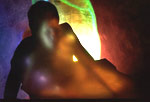
real time interactive performance event
Carol Brown Dances explores real and mediated bodily presence. Recent work The Changing Room is a real time interactive performance event intertwining the digital and the visceral in a sublime trio. In their changing room, three women leave behind the territory they know for another place, beyond what they know. A mirror becomes a screen for their mutations, a curtain a technological frontier and their table a platform for the puppetry of the virtual. Through a series of changing viewpoints the audience is lead to encounter the epic within the everyday, as a haunting virtual presence extends, mirrors and distorts the performer's behaviour. Animating the threshold between the virtual and the real, The Changing Room is an intimate exploration of our digital evolution. Designed for both live art and theatre spaces, The Changing Room encourages the shifting viewpoints of a mobile audience.
"The work which really stood out for me in Dance Umbrella for its boldness and imagination was "The Changing Room," from Carol Brown Dances, seen November 5 at Greenwich Dance Agency. Choreographer Carol Brown and architect Mette Ramsgard Thomsen transport the audience into another dimension, a world of virtual and real bodies in their challenging and creative work performed as an installation, around which the audience promenades, guided by Brown herself. Different performance areas are demarcated by one large screen and several smaller screens onto which a 'virtual body' or 'avatar' is projected. The virtual body, central to the work which is created by a technique called contour tracking, feeds off the dancers' movement. It is a mesmeric swirl of colour, circular in shape, that takes on different forms and resembles a pulsating sea anemone, a mutating cell and even a developing embryo.
"The performance by Brown and two dancers, Catherine Bennett and Delphine Gaborit, takes on the style of a lecture-demonstration in which the choreographer explains in poetic metaphorical language how they have worked as live bodies with something that is not tangible or organic. In her performance text she talks about the limitations of the organic body and how the virtual body could be something that does reach perfection, as it extends the possibilities of the physical body, "following our contours like distant geography." The most poignant and indeed emotive moments in the work are the points of connection between the dancers and the virtual body -- for example, when the dancers trace or touch the fluctuating presence on the screen or dance with it from a distance, retaining, still, a sensitivity, a constant awareness of this 'other.' Likewise, the virtual body, while visually powerful, never dominates the live action, but rather has a symbiotic relationship with it. Movements are adapted to activate the virtual presence; it can only feed off certain movements or dynamics and this poses limitations on what the body can do physically as well as offering other potential.
"A theatrical quality is established by the frequent costume changes of the three dancers, Michael Mannion's lighting and Jerome Soudan's score. Shanti Freed's costumes feature white fitted tunics which can be stretched into all kinds of shapes, thus extending the body like a second skin; baroque fashion accessories such as a white fur coat, a red satin glove and red stiletto shoes; and white underwear stripped down to reveal the muscle and flesh of these live bodies. Soudan's rich musical text, combining electronic sound and collages of classical music and monks' chanting, further wraps the work in more layers of meaning. The dancers look at times like high priestesses in a Sci-Fi film, or sometimes like Replicants but never like ordinary dancers. The lighting design, white space and screens, the text, choreography, sound, costumes and appearances of the virtual body transform the space into a cocoon-like research laboratory, an interface where different worlds meet, where each element/component co-habits or even merges. However you interpret it, "The Changing Room" is about a 'meeting,' and the three women performers are like pioneers on the verge of discovering a brave new world. The last image that we are left with is the virtual body diminishing slowly and softly, the child of these women inventors.
"The Changing Room" was the result of nearly two years of experiment and research. Thomsen, an architect working in new media and virtual environments, worked closely with Brown on how to mix realities -- that of the virtual and the live -- and developed a way of working with experimental choreographic systems which was based on Brown's interest in merging new media with dance-theater. Another enlightening aspect of "The Changing Room" is that it deals with women's bodies, and suggests birth and creation, which is refreshing in the field of new technologies, so often dominated by men sitting behind computers. "
From Flash Review
Posted by michelle at 11:35 PM | Comments (0)
February 14, 2005
Troika Ranch

Three by Troika
In Plane (1994) was a duet for a dancer and her video image representation. The dance used the MidiDancer system to allow the performer to control the generation of music, the recall of video images, the theatrical lighting and a the movements of a robotically controlled video projector.
The Electronic Disturbance (1996): Searching for the corporeal within the virtual: a "tri-coastal" dance theater performance. Inspired by the book of the same name by The Critical Art Ensemble, The Electronic Disturbance shows the human body in flux: a body whose contact with other bodies comes more and more often not physically, but electronically. The piece explores the liberating aspects of this "electronic" body, like freedom from time or gravity, as well as the more sinister implications of a body that might be easily manipulated by external forces.
Surfacing (2004) combines dance and media to explore how tiny apocalypses and the grandly commonplace create imaginary surfaces through which we may either emerge or remain held captive. Troika Ranch's Artistic Directors, choreographer Dawn Stoppiello and composer/media artist Mark Coniglio, have created a world where real-time movement is captured by onstage cameras and subsequently trapped inside the surface of the video screen. The interplay of the real and the virtual asks the question, are you on the inside or the outside, and do you have the courage to break through?
Posted by jo at 02:56 PM | Comments (0)
February 10, 2005
Dziga Vertov Performance Group
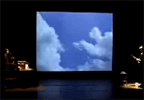
Performance Hybrids
Founded by artist/director Douglas Rosenberg in 1991, Dziga Vertov Performance Group's purpose is to create works bridging numerous disciplines including dance, performance and the visual and media arts. It takes its name from the Russian filmmaker of the early 1900's. DVPG's fundamental mission is to create new and challenging works of art based in the language of performance, dance and media that often combines voice, text, video and projected images. The work of DVPG is concerned with both content and form. The purpose of the work is to engage the audience, other artists and community groups in a dialogue that reaches beyond the usual performer/spectator relationship. In order to do this, we have set out to create a hybrid form of performance that is intended to both engage and challenge, using concepts and images that speak to contemporary and historical issues of human existence.
One of DVPG's many projects is ADaPT, an interdisciplinary association of artists, technologists and scholars from five educational institutions dedicated to research and critical dialogue on performance and media in telematic space.
ADaPT comprises five dance studios in five universities in the USA.:
1. Arizona State University
2. Ohio State University
3. University of California-Irvine
4. University of Utah
5. University of Wisconsin
In Wisconsin, the ADaPT team consists of Douglas Rosenberg (principal investigator), Chris Dowling (telematic technologist) and Jeffrey Gray Miller (technical director).
The objectives of ADaPT are to:
* create a site for telematic collaborative inquiry for the purpose of developing new models of practice and training techniques for the creation of networked dance and performance
* explore embodiment and somatic intelligence through reconceptualization of spirit, body and machine in Internet 2 culture- develop a shared mediated space for investigating performance and creative collaboration through a distributed environment across time zones
* situate research within a larger cultural and political context that acknowledges how mediated performances both frame and are framed by issues such identity, privilege, and access.
Posted by jo at 11:48 AM | Comments (0)
February 09, 2005
Excellent video dance in Tokyo:

Asami Tachibana and Yoji Toyosaki
Asami Tachibana's "Women who never gather in group" was excellent video dance in Japan. Asami Tachibana studied dance at Annex Sengawa Factory with Miyako Kato in Tokyo. Kato was a talented choreographer of modern and post modern dance. Thus, Tachibana is also influenced by Japanese modern dance and contemporary dance. She also studied dance in Belgium.
In the video dance, they mixed red Japanese female dancer's body and their expressive motion. Video image directed dancers' movement softly. In particular, Mariko Konno, who is one of the star dancers in Japanese Dance World, performed sharply and elegantly Ayaka Azechi, a daughter of Miyako Kato, also danced in this piece. Azechi performs at Tokyo in her own concept, "body installation" these years.
A video artist, Yoji Toyosaki, has worked with dancers and musicians for years. Some parts of images, for example, scales of objects, remind Japanese traditional art to the audience. Just as an effect of sliding projector, the images changed one by one in the stage. [posted by Yukihiko YOSHIDA]
Posted by jo at 09:30 AM | Comments (0)
January 30, 2005
The first session with ADaPT Tokyo
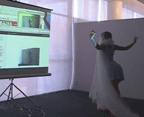
First Big Step in Japanese Dance World
In Japan, there has been few groundwork for media performance for years. However, there is few infrastructure in this field. I have been constructing interdisciplinary dance researchers' network inside Japan and Asia Pacific. I have started working for them since 2004. In the rehearsal of ADaPT Live Event Participating Performance Teams, a test session was held. A Japanese choreographer, Saeko, danced her piece "Veil," and Johannes Birringer and staffs at Nottingham (UK), and Kelly Gottesman at Wayne State University saw her dance image. I believe that it was a first big step in Japanese dance world. Related URLS: LATela: Live Art Telematics Lab: ADaPT also initiated the first transcontinental interface-performance between partners in the West and the Far East by Johannes Birringer; ADaPT Tokyo (Japan). [Posted by Yukihiko YOSHIDA]
Posted by jo at 01:14 PM | Comments (0)
January 27, 2005
Here I come again (Flying Birdman)

Between Sites and Non-Sites
Here I come again (Flying Birdman) was a telematic "earthwork" - an earthwork dance linking five remote sites in the United States with two locations in Brazil. It was based on narratives/dreams and structured spirally as a "Renga" (the old Japanese form of a linked poem) composed of live dance; real-time audio and sound processing, pre-recorded filmic images; still images, and both spoken voice and graphic text communication exchanged by participants during the live performance.
Thematically, the performances delved into "left overs," debris, decomposing sites, dumps, and the idea of re-cycling of landfills: what is returned needs to be transported from one site to another. The dramaturgy for this telematic "earthwork'" envisioned a spiraling dialogue/communication -between sites and "non-sites"- with at least 2 sites dialoguing with each other (video, audio) at any given time during the 10 scenes. The dialogue was passed on and moved around, as in the Renga for of a linked poem. The online viewer was invited to follow the spiral. View movies >>
Posted by jo at 08:56 AM | Comments (0)
January 26, 2005
The Dream Project

Reinforcing the Disparity Between Virtuality and Physicality
In the teleconference performance The Dream Project--by Keith Roberson and Company in Space--performers wearing datasuits control virtual avatars in a shared virtual reality environment. Bridging the gap between multiple locations, these avatars interact with each other. Their interactions explore possibilities beyond the physical body. Choreography of these virtual bodies, based on Quantum and Super-string theory, reinforces the disparity between virtuality and physicality.
Posted by jo at 11:13 AM | Comments (0)
January 24, 2005
Binary Ballistic Ballet

Silent Virtual Dancer
In Michael Saups Binary Ballistic Ballet participants send audio-signals through a microphone to a computer which transforms them into abstract shapes. A dancer then translates this information displayed on a computer monitor into a dance pattern on the stage.
The interactive choreography system "Binary Ballistic Ballet" was developed for the ballet piece "Eidos Telos" by William Forsythe, which was premiered in January 1995 in Frankfurt. The ensemble had already been experimenting with an alphabetical dance- system which was then transformed into movement in 3dimensional space-time. For this production this alphabet needed to be ported onto a computer platform to make it more fluid.
In part 1 and part 3, the computer picks words from the word-database and displays them on several monitors that are only visible to the dancers. As a new word appears, it will be directly influenced by the incoming soundtrack, i. e. the musician on stage can change the appearance of the current word in the following ways:
* depending on frequency and amplitude of the incoming audio-signal, the words can be rotated and translated;
* depending on amplitude, the words can be transformed into more abstract shapes, i. e. the words are interpolated into more DNA-like forms;
* a spectral plot of the audio signal is created;
* lines are used to visualise the history of the system.
The dancers can therefore decide which information they will choose:
* the alphabetical index of the word (red color);
* the color of the word, which is based on musical history;
* the direct meaning of the word and its transformation into dance patterns;
* the movement of the word in computer spacetime;
* the line-history on the display;
* the deformation of the word in space;
* the spectral information of the sound.
The choreography is generally as much as 70 percent predetermined. The remaining 30 percent will be influenced by the computer system, which means that the dancers receive the information from one of the computer monitors and immediately transform it into dance patterns. The setup of the system reacts like a feedback loop between musician, dancer and computer.
In part 2 the computer is used to build "interactive creatures" that also react to incoming sound, for instance the monologue of a performer. Here we also have a "silent virtual dancer" that constantly interpolates between complex geometric shapes and accompanies the dancers on stage reacting to the soundtrack. The resulting graphics are displayed as a part of the stageshow. [via Ars Electronica]
Posted by jo at 03:12 PM | Comments (0)
January 18, 2005
Tap
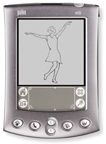
A Metaphor for Networked Communication
Tap--by James Buckhouse in collaboration with Holly Brubach--is a virtual dance school for animated characters that exist on the Internet and can be downloaded to individual users’ Personal Digital Assistants (PDAs) and desktops. Users can choose animated dancers (a male or female) at the Tap website. The dancer takes on a life of its own, practicing, learning from other dancers, and giving recitals. Users do not have to be present during the lessons--the animated characters can be "dropped off" and left to practice for an unlimited time. Dancers can practice at home, as a screen saver on the user's desktop. Their learned routines can be performed for other users.
These performances take place on individual users' PDAs. Dances are downloaded from users' desktops or beaming stations to their PDAs, where they can be performed as well as "beamed" to other PDA users. The dance contains a record of what it took to learn a particular routine. Individual steps from a dance can be incorporated into new dances, and users can encourage their character to continue working with certain moves. Also, two users can let their characters teach each other to dance.
Tap treats digital data not as perfectly reproducible packets of information, but as seeds for new ideas that spread and evolve. As an artwork that relies on exchange, learning processes, and community, Tap becomes a metaphor of networked communication itself. As digital data, tap dance is modular and re-mixable. The similarities between data and the dance routines point to the question of how we think about art through the cultural filter of technology.
Posted by jo at 06:15 AM | Comments (0)
December 31, 2004
Big

Hyperchoreography
The final edit of a dance film is only one ending in a range of infinite possibilities. The sequence of the material is essentially down to artistic decisions made at a particular point of time in the edit, usually by the editor and director of the work. Hyperchoreography offers an alternative approach. Using digital hypermedia, Hyperchoreography is a non-linear dance performance 'space', existing in an interactive, networked medium. The elements are put in place by the creators, but the shape of the work is decided by the user at the moment of interaction.
Big represents one particular train of thought within the greater concept of Hyperchoreography. It offers the chance to explore a body of edited material whilst creating a multi-screen video-dance work.
Posted by jo at 10:43 AM | Comments (0)
December 27, 2004
netzwissenschaft
![]()
Emerging Infrastructures of All (Inter)net Research
Dr. Reinhold Grether's network research | netzwissenschaft site maps the "emerging infrastructures of all (inter)net research endeavours. net.science as an anthropology of connectivity is trying to overcome the constraints of specialist method transfers on net matters. the protuberance of technical networks necessitates a professionalization of human net knowledge. neither the isolation of concepts as in basic research nor the encapsulation of processes as in applied sciences will ever be able to adequately describe the complex autopoiesis of networks. net.science is undoubtedly developing into a scienza nuova of its own right."
Check out his Mobile Art and Virtual Performance research areas.
Posted by jo at 04:45 PM | Comments (0)
November 15, 2004
Capacitor

Capacity for Charged Performances
Capacitor* is a group of interdisciplinary movement artists that accumulate energy from our technologically impacted culture and release it through innovative, multi-sensory performances. One of their pieces, Avatars (2002), takes the characters and themes of computer games and incorporates them into their performances. (Video clips are available of this performance).
From the movement of the human diaphragm to the story of evolution; from the behavior of electricity to genetic manipulation; from the birth of the moon to the cycles of digestion - science and technology form the basis for Capacitor's study of performance. Obsessed with the mechanics of the human body as well as machines that propel the body through space, Capacitor artists have become masters of rigging systems and large-scale props designed to stretch the limits of physical poetry. [via]
*ca·pac·i·tor (kƒ pas‚i tƒr) n. a device for accumulating and holding a charge of electricity.
To cultivate new and relevant performance concepts, Capacitor developed the Capacitor Lab, a think-tank of artists engineers, scientists and philosophers who exchange ideas, share knowledge, and ignite each other's imaginations towards the creation of innovative performance pieces.
The lively dialogues and debates that take place in the Capacitor Lab bring a broader outlook to the creative process and provide a vehicle for critical feedback as new work is developed. By engendering dialogue around contemporary technological and scientific issues, Capacitor aims to find common ground amongst individuals from varied fields of inquiry and, together, shape a new performance aesthetic built on today's innovations.
Capacitor has created works that tackle the creation of the universe (Within Outer Spaces, 2001), the past and future of mankind (futurespecies, 2000), the modern phenomenon of video gaming (Avatars, 2002) and, most recently, a journey through the visible and invisible layers of the Earth (Digging in the Dark, 2004). Capacitor's uncanny and contemplative use of technology won the company an invitation to speak at the Monaco Dance Forum in 2002 and has been covered by Computer Graphics World, Wired.com, SHIFT Magazine, NBC 11's Tech NOW!, CNET Radio, TECH TV, Dance Magazine and The New York Times.
Founded in 1997, Capacitor is grateful for support from San Francisco's Grants for the Arts, California Arts Council, the Zellerbach Family Foundation, Altria Group, Inc., the LEF Foundation, Theatre Bay Area, and the American Composers Forum.
Posted by jo at 10:35 AM | Comments (0)
November 04, 2004
Net Guerrilla Ballet
![bi-ir_pr01[1].jpg](http://www.turbulence.org/blog/images/bi-ir_pr01[1].jpg)
wireless illegal remote-controlled net-ballet invasion
Ballettikka Internettikka is an ongoing study of the internet guerrilla performance.
Slovenian ballet dancer Igor Stromajer and composer Brane Zorman will be replaced by toy-robots which will invade the kitchen of the famous [theatre x] and dance an illegal wireless roboballet there. The robots and cameras will be remotely controlled from a mini-van parked in front of the [theatre x].
Live internet broadcasting of the guerrilla ballet performance will start on November 13th 2004 at 20:00 GMT+1 and will last 10 to 15 minutes; the location will be made public on November 13th at 18:00 GMT+1. [Via]
They will enter the kitchen of the famous [theatre x], where bio-food for artists is prepared. The kitchen of the [theatre x] is an excellent example of a modern cooking laboratory for healthy food. It is automatized and meets the highest hygienic standards. The artists will use two remote-controlled toy-robots with two wireless web cameras. Robots and cameras (algorithm of the ballet choreography and MP3 orchestra) will be remotely controlled from a mini-van parked at the north-east side of the [square x] in front of the [theatre x].
This time, Stromajer and Zorman (as ballet dancer and musician) will be replaced by robots, lonely and sad icons, automatized units, which will have no major problem to invade the kitchen of the famous [theatre x] and dance the net-ballet there. Toys transform into guerrilla-ballet dancers.
Stromajer and Zorman will approach the [theatre x] full of respect towards the [theatre x] and its rich history.
Artists will use hi-tech mobile and wireless equipment for the invasion and live broadcasting (portable computers, mini digital camera, MP3 audio systems, mobile WAP telephones etc). A laptop and MiniDV cam, together with Webcam32 (version 6.0) software will be used for broadcasting the video signal (running over Intima Virtual Base FTP server). Another laptop and MP3 player with online interface SHOUTcast (version 1.8.3/win32), will be used for live sound broadcasting (running over Beitthron FTP server). A local GSM mobile phone operator will be used for GPRS mobile internet connection.
# Timetable of the action in [theatre x] - 13. 11. 2004:
11:00 - test and calibratethe equipment, micro-locate at ground zero
19:30 - park mini-van at the north-east side of the [square x] in front of the [theatre x] and secure the location
19:45 - robots enter the kitchen of the [theatre x]
20:00 - start of the live internet broadcasting
20:15 - end of the internet broadcasting
20:20 - robots exit the kitchen of the [theatre x]
20:35 - leave [square x] in front of the [theatre x] and secure the material
Dancing an illegal wireless roboballet in the kitchen of the [theatre x] represents a big conceptual and strategic challenge to the Intima Virtual Base, therefore the preparations have been taken serious, safety measures have been calculated, and the previous experience from the Bolsh.oi Theatre in Moscow has been very welcome.
Note: [theatre x] does not voluntarily co-operate in the project, but was selected based on the conceptual strategy of the project. The management of the [theatre x] is not a co-producer of this project and does not co-operate in the process of its realization.
Project supported by The Ministry of Culture of the Republic of Slovenia
About the authors:
Igor Stromajer is an mobile intimate communicator. He researches tactical emotional states and traumatic low-tech strategies. He has shown his work at more than a hundred exhibitions in forty-two countries and received a number of awards. His works are included in the permanent collections of the Centre Georges Pompidou, Paris; the Museo Nacional Centro de Arte Reina Sofía, Madrid; Moderna galerija Ljubljana, Slovenia; Computerfinearts Gallery, New York.
Brane Zorman is a composer and sound manipulator. Between 1982 and 1986 he was frontman for the Slovene punk group O!KULT. He is a pioneer of Slovene techno scene. Since 1987 he has been composing music for both Slovene and international theatre, dance and multimedia performances and projects. and has made guest appearances throughout Europe. Recently he works with Irena Pivka on a
series of audio-visual installations ZONE.
Ballettikka Internettikka PRESS (2001 - 2003):
...The eleven minutes of live webcasting were watched by more then 400 people. An amazing amount, which even the artist did not expect. Not only did they see Igor Stromajer dancing, but they also saw the conductor of the 'mp3 orchestra' - as Stromajer calls MC Brane - who ironically conducted the mp3's on his laptop like a true Herbert von Karajan. The video of the whole event catches the excitement of the event well. Shot in black and white it leaves one a bit with the feeling of watching an avant-garde performance straight from the early twentieth century, if it weren't for the laptops and mobile phones of course. Both dancer and conductor wear a kind of miners light on their heads. The movements of the light, the speed and accuracy of the operation, the bare abandoned basement and the concentrated moves by Stromajer and MC Brane create a sense of conspiracy that replaces the so called interactivity of on line art without it being missed. In a way it is still there, in the intimacy of the small circle of people who watch this event live, while the management of the Bolsh.oi theatre watches a classical ballet.--# "Claiming the Stage: Ballettikka Internettikka pt 2" by Josephine Bosma, Cream, Amsterdam, Nizozemska (25.04.2002)
Posted by jo at 11:43 AM | Comments (0)
September 18, 2004
Re:action
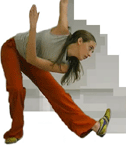
questions of authorship
Re:action is a website and audio visual installation which uses contemporary dance to infuse new media art with the qualities of performance. What first appears to be a dance film in a continuous loop, over time shifts and changes. Unlike a conventional film, the scenes that make up Re:action are not always shown in the same order or from the same viewpoints. Re:action is being re-edited as the viewer watches. However, this re-editing process is controlled not by the artists but by the active participation of the website audience. Simultaneously, the spatial soundscape overlaps in constantly different ways as the viewer moves through the exhibition.
Each journey through the website is recorded and then fed through to the installation, resulting in an outcome which exists only in the moment. The work is constantly remade as each new website user interacts with it in a different way. The control the artists have over the outcome is diminished, emphasising the questions of authorship that arise through collaboration, by extending the collaboration to include the audience.
Re:action is a collaboration between Ed Holroyd, interdisciplinary arts company Eshoda Arts, and filmmakers from Suited and Booted Studios.
Posted by jo at 07:49 AM | Comments (0)
September 16, 2004
Extensions Online Journal

for Embodied Technology
The editors of Extensions: The Online Journal for Embodied Technology are pleased to announce the launch of Volume One. Included are six provocative essays by authors concerned with the many new points of contact between our bodies, digital technologies, and aesthetics; and six artworks engaging themes of memory, identity, perception, and performance.
EXTENSIONS is produced by the UCLA Dance and New Media Project. The Project brings together graduate students and faculty from the departments of World Arts and Cultures, Design Media Arts, and Film/TV to explore new intersections between dance and emerging technologies and how virtual space affects our sense of the body, place, culture, and collaboration. Founded in 2002 by Norah Zuniga Shaw, the Dance and New Media Project produces EXTENSIONS and presents annual dance on camera screenings for new work by UCLA students and faculty.
Posted by jo at 09:46 AM | Comments (0)
September 09, 2004
tanz performance köln

European Complements
tanz performance köln founded in 1989, develops concepts and realizes dance-related series, festivals and dance film programs, that are representative of new developments in contemporary dance both nationally and internationally including projects with a strong focus on new media technologies. Their projects include DAMPF_lab, an interdisciplinary collaborative project fostering new and distinctive art works of high quality that integrate interactive media technologies with the performing arts while seeking insight into questions such as: how do emerging software practices impact performance; what is the experience of the performer on an interactive stage; how are the relations between maker, performer and audience still shifting; and what are the aesthetic/social consequences?
tanz performance köln partners include:
Animax Multimedia Theater (est. 1999) of the Bonn Development Workshop for Computer Media (est. 1985) focuses on the roduction/presentation of media arts and provides an outstanding operational basis for the exploration of new interactive technologies in the area of performance arts and immersive arts.
Ars Electronica Center/Futurelab offers one of the best-equipped and most efficient research and development workshops for Interactive Spaces, Virtual Environment and Digital Surfaces in the context of Ars Electronica which has been an internationally unique showcase for digital art and media culture and encounters between the arts and sciences since 1979.
V2_Lab is the aRt&D department of V2_, Institute for the Unstable media (est. 1987) that concerns itself with research and development in the field of art and media technology and brings to the project a variety of knowledge/ expertise derived from an interdisciplinary approach to the field of unstable media including specific critical perspectives.
Partners work on the following complementary strands:
research labs aiming to generate shareable outcomes by drawing questions from and in turn supporting the creative work of the co-productions; stimulating other new artistic work; innovating technology solutions together; and devising unique dramaturgical and user testing approaches to the artistic process. In addition, the labs will gather documentation to contribute to theoretical and educational approaches to this area of work.
co-productions aiming to nurture and help realise two specific art works: composer/director Klaus Obermaier working with the Ars Electronica Futurelab to develop interactive media technologies for use in a new performance for the stage; and choreographer Angelika Oei working with the V2_Lab on the creation of a large scale performance/ interactive media installation work.
Associate researchers:
Matt Adams (Brighton/ London)
Daniel Aschwanden (Vienna)
Johannes Birringer (Nottingham)
Carol Brown (London), Nuria Font (Barcelona)
Nik Haffner (Frankfurt/ Barcelona)
Prue Lang (Frankfurt), Cindy Lee (London)
Martin Kusch (Vienna/ Montreal)
Christopher Salter (Berlin)
Stephanie Thiersch (Cologne)
Ariella Vidach (Milan)
Posted by jo at 01:09 PM | Comments (1)
September 02, 2004
M@ggie's Love Bytes
theater that dares
M@ggie's Love Bytes is a dance theatre performance ocurring in real and virtual (net) space. Participants - M@ggie and her lovers - interact through sound, text, and realtime video conferencing via the Internet. Love Bytes are given to M@ggie in the form of digital signals. The hardcore performance group consists of a choreographer, two musicians and three dancers.
This is a post-modem project, using the Internet as a platform for interaction. The restrictions of the chosen technology are used as an expression of Now! This project focuses on connection and disconnection, appearance, disappeareance and reappearance. Fluctuations in transmission and reception rates between the geographically separated participants are embedded in the expression of the performance, and define the dramatical development of the piece.
M@ggie is represented physically by three dancers, each dressed in bra and pants and equipped with a plunger. M@ggie relates strongly to the soundscape. M@ggie's lovers enter the performance from such diverse locations as Cologne, Yokohama, London, San Francisco and Copenhagen.
While some remote participants are regularly active as collaborators (musicians and dancers who are involved in rehearsals), others enter the project for the first time during performance. You'll find a downloadable RealVideo (494k) introduction to M@ggie HERE which'll give you more of an idea about who she is :)
Each participant is free to choose their own form of interaction. Each remote participant experiences their own unique performance on their computer desktops and in their local spaces - some choose informal party settings, others create their own scenic settings inviting their own audiences. In addition to the live interactioin described above, audio and visual gifts from visitors deposited in M@ggie's Giftbox, are integrated into the performance. By using several interwoven physical and virtual platforms for interaction, a multitude of simultaneous telephonic spaces occurs between the diverse physical locations.
Here is a review from the show @ Electra, march '96.
Posted by jo at 06:49 PM | Comments (0)
August 08, 2004
Eurodans
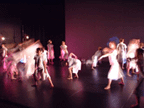
Collaborative Choreography
Eurodans was a choreography project on the Internet. It linked dance students from selected higher education institutes across Europe. This project was a partnership between University of Leeds and ULTRALAB, working with European League of Institutes of the Arts Dance Section. The dance students worked in their own institutions across Europe, collaborating via the Internet. They used the Snugfit software to build Web pages within a password-protected site. These pages were records of the dancers' rehearsals using movies, images and text. Two choreo-coordinators ensured that a single dance was created between all the groups. Read a paper about this process.
Posted by jo at 05:36 PM
August 05, 2004
wannaboogie.com

Staccato Movements
wannaboogie.com is the outcome of endeavours to create innovative dance that, unlike conventional dance, is viewed on the internet rather than on the stage, cinema or television screen. It is both a performance piece, which can be streamed over the web, and an interactive choreography piece enabling the viewer to interact with the choreography and create their own dance piece to accompanying music. (more)
Posted by jo at 06:53 PM | Comments (0)
July 31, 2004
Historically Locating Distributed Performance
2004.04.05 Helen Thorington, writing about an early conference proposal:
The following are examples of distributed performances:
Finding Time (Jesse Gilbert, 2000). Finding Time linked performers on six continents in a series of live musical events, each an hour’s duration.
World Wide Simultaneous Dance (1998, Laura Knott). The project took place simultaneously in twelve countries.
In both examples the performers played to audiences in their performance spaces and to a worldwide Internet audience by means of especially created websites.
I then move on to a brief history, beginning with Kaprow's "Hello Hello" in the mid-60s--about which I can find very little information other than that it linked five sites in a television event. And on to Kit Galloway and Sherri Rabinowitz.
But the history is the not the question for me. Internet works resonate with historical issues. But what I'm beginning to think as I research for the conference is that we may already have witnessed the passing of the (pre)structured presentation of large-scale performance works--I keep thinking, for instance, that while Adrift (1997-2001) was very different from other works produced at its time, it was also very traditional. It was a work by three artists (the senders), in which its audiences had no agency at all--Like radio, like television, they were cast in the role of "receivers."

From the Adrift performance
Now...when did it happen?...the Internet environment is in a far more participatory stage and people-interest runs to works/platforms/
environments in which the former viewer can play an active role. Which may begin to explain why there are really not very many interesting large performance works being produced at this time. Not only is the technology still difficult but the environment is no longer congenial.
Or am I wrong? And if not, what does this do for/to our conference?
I'm going to think about this for awhile. Right now my only thought is that if this is so, the conference itself should reflect it and include the many twists and turns performance has taken in the last years.
Posted by michelle at 01:22 PM | Comments (0)

